Technical Support FAQ:
Band-in-a-Box® 2021 for Macintosh
To search the FAQ, look through the FAQ titles below or press CTRL-F on your keyboard and enter a search term.
Please contact support@pgmusic.com if you would like to report any errors that you find on this page, or if you have any suggestions for new FAQ topics.
Last updated: Friday, 08 April 2022
Most Common Topics
- No Sound / MIDI and Audio Setup
- How can I save my Band-in-a-Box® songs as MIDI or Audio files, and import them into other applications or burn an Audio CD?
- How do I install Band-in-a-Box®, RealDrums, and RealTracks?
- Why don't my Styles appear in the StylePicker window?
- Is the latest version of Band-in-a-Box® backwards compatible with songs from older versions?
- I am having trouble downloading files from your site.
- How can I return Band-in-a-Box® to the factory settings?
- I need assistance with a hard drive version of Band-in-a-Box® that I purchased.
- Can I install Band-in-a-Box on Mac OS 10.15 (Catalina) or higher?
- Is the 32-bit version of Band-in-a-Box still included with version 2019 and higher?
- I've installed Band-in-a-Box, but when I try to run it I get error messages and the program doesn't open properly. The errors may refer to folders not being present or writable and/or refer to several missing files.
- I ordered an upgrade from a previous version - should I remove the previous version prior to installing the new version?
- What is the best way to check if I am missing any content like Styles and RealTracks?
- I ordered an UltraPAK or PlusPAK upgrade as a download product... how do I download and install the RealTracks?
All Topics
- No Sound / MIDI and Audio Setup
- What is MIDI?
- How do I enter notation in Band-in-a-Box®?
- How do I create a shortcut (alias) on my desktop to open Band-in-a-Box®?
- How do I add my personal styles to the Band-in-a-Box® StylePicker list?
- How can I make my song endings more natural? Can I hold the last chord in the song and have it fade out?
- How do I display 'Swing' notation (triplets) and 'Even feel' notation (sixteenths) in the same song? How do I enter quarter note triplets?
- How do I use tag endings?
- Can I import and play MIDI files with Band-in-a-Box®?
- How do I change from 3/4 to 4/4 time in the middle of my song?
- How do I create and use Band-in-a-Box® Styles in 6/8,12/8,9/8 and 5/4 time signatures?
- Who owns the songs that I create with Band-in-a-Box®? Are the songs copyrighted?
- How do I rest more than one bar at a time?
- How can I easily raise or lower the velocity (volume) of all notes in the melody track?
- Can I enter a melody into Band-in-a-Box® using the computer keyboard?
- I am having trouble recording into Band-in-a-Box® with my Wind Controller.
- How do I get chords to sound on the off-beat, or create syncopation in my music?
- Please explain the song structure in Band-in-a-Box®.
- How do I access higher bank patches in Band-in-a-Box®? What are MSB and LSB?
- How do I make a patch map for my synthesizer?
- How can I save my Band-in-a-Box® songs as MIDI or Audio files, and import them into other applications or burn an Audio CD?
- Can Band-in-a-Box® input chords for my melody?
- Why don't my Styles appear in the StylePicker window?
- How do I enter more than 2 chords per bar in Band-in-a-Box®?
- How do I enable and disable the lead-in bars or count-in?
- Why does Band-in-a-Box® generate notes below low E (E2) on a MIDI bass part?
- How do I set the right key or visually transpose the music for my non-concert instrument?
- How can I control Band-in-a-Box from an external start switch?
- Can I edit tracks other than the Melody and Soloist in Band-in-a-Box®? Why do the notes I just edited disappear when I press play?
- When I run Band-in-a-Box® I get error messages such as: "cannot read/write files", "zzjazz.sty not found", "Disk Write/Read Error", "Unable to save file", or "Unable to create file".
- When I run Band-in-a-Box®, it gives me a message talking about permissions and admin users. Can I run Band-in-a-Box® on a non-administrator (standard) user account?
- Are Mac and PC versions of Band-in-a-Box® songs compatible?
- Is the latest version of Band-in-a-Box® backwards compatible with songs from older versions?
- How do I control the MIDI sounds I hear when I record or play live along with Band-in-a-Box® from my MIDI keyboard?
- I am having trouble downloading files from your site.
- The Notation Window doesn't display properly, or I get Font errors when running the program. How do I install the PG Music fonts?
- When I try to open Band-in-a-Box®, I get the message that it is not supported on this system.
- How do I install Band-in-a-Box®, RealDrums, and RealTracks?
- Can I disable the yellow help boxes that pop up when I move my mouse over the screen?
- How can I return Band-in-a-Box® to the factory settings?
- When I try to run Band-in-a-Box® on a multi-user system, I get errors when opening or closing the application.
- I need assistance with a hard drive version of Band-in-a-Box® that I purchased.
- Explain the different file extensions that Band-in-a-Box® uses for song files.
- Why do I get an ".ST2 not found" message when I play a song with RealTracks or generate a solo?
- The chord symbols in my song don't show up when I save the song as a MIDI file and import it into another program.
- Can I import my Band-in-a-Box® song into GarageBand?
- How do I use Band-in-a-Box® with other applications and software synthesizers?
- Why does the Melodist generate notes outside the "Melody Note Range" specified in the Melodist editor?
- How do I get a simple metronome or click track in Band-in-a-Box®?
- When I type a chord into the chord sheet, it automatically transposes my chord and displays a different chord than what I typed.
- Where can I find a list of the chords that Band-in-a-Box® recognizes?
- Is Band-in-a-Box® compatible with older Mac operating systems and old PowerPC Macs?
- When I try to open Band-in-a-Box®, I get the message "You do not have permission to open the application Band-in-a-Box®".
- How do I install update patches for Band-in-a-Box®?
- Can I store the RealTracks and RealDrums on a different hard drive than the Band-in-a-Box® program?
- Which RealDrums and RealTracks styles are included in each of the Sets?
- What are the green lines underneath some of the RealTracks at the top of the main screen? What do N and Gt stand for in the RealTracks window?
- What is the difference between a 'RealTracks Style', a 'Style with RealTracks', and a 'RealStyle'?
- How do I make my own RealDrums styles?
- Can I install Band-in-a-Box on Mac OS 10.15 (Catalina) or higher?
- Is the 32-bit version of Band-in-a-Box still included with version 2019 and higher?
- I've installed Band-in-a-Box, but when I try to run it I get error messages and the program doesn't open properly. The errors may refer to folders not being present or writable and/or refer to several missing files.
- When I try to run Band-in-a-Box, it says required files are missing, or displays a blank dialog box.
- Can I run Band-in-a-Box on a non-admin account?
- How do I install Band-in-a-Box on an external hard drive.
- How do I install a Band-in-a-Box update or patch to an external hard drive?
- How do I install RealTracks or "RealCombos" or other Band-in-a-Box content on an external hard drive?
- I don't seem to be able to choose an external hard drive for installation.
- I am installing RealTracks. How do I choose a custom RealTracks (and Drums) folder location?
- I ordered an upgrade from a previous version - should I remove the previous version prior to installing the new version?
- What is the best way to check if I am missing any content like Styles and RealTracks?
- I upgraded and don't seem to have some Band-in-a-Box add-ons like Xtra styles that I have purchased in the past?
- I ordered an UltraPAK or PlusPAK upgrade as a download product... how do I download and install the RealTracks?
- When I try to run a downloaded installer, I get a message that it can't be run because it is not from an identified developer, not from the app store, or it cannot be checked for malicious software.
- I am getting various security warnings while installing and running Band-in-a-Box, asking if it's ok to allow Installer to control Finder or do specific tasks.
- How do I set Band-in-a-Box as the default app to open all Band-in-a-Box song files.
- When I try to run the program, I get "Error - Cannot read/write files". The error message typically mentions a problem with Data and Preferences, and points to a long folder path under the /private/var/folders directory.
- Can I install and run Band-in-a-Box from a network drive?
- Can I copy the entire Band-in-a-Box folder to another hard drive?
- Error message when opening Band-in-a-Box: Unable to open file ... RealTracksSubs.txt
- Error message when opening Band-in-a-Box: Unable to create file ... stylz_kategoriesERRORS.txt
1. No Sound / MIDI and Audio Setup
Band-in-a-Box® uses a mixture of both audio and MIDI. Audio refers to RealTracks and RealDrums, which don't require a MIDI synth to play - you will hear the "Real" instrument tracks even if you don't have a MIDI driver properly set up (provided your speaker volume is turned up). Band-in-a-Box® songs may have only MIDI, some MIDI and some RealTracks/Drums, or ALL RealTracks/Drums. To identify if your song is using MIDI or RealTracks, look at the track names in the instrument panel at the top of the main Band-in-a-Box® screen - Bass, Piano, Drums, Strings, Melody, Soloist. If a track name is black it is a MIDI track, if it is green it is a RealTracks or RealDrums track. If it is red then the track is currently muted. You can mute/un-mute/solo any track by control-clicking on it and choosing the appropriate menu item.
The easiest way to set up MIDI, is to use the Mac's built-in sounds (Apple DLS Synth). This requires very little setup, and should work automatically. If not, check Options | MIDI input/output ports and select "MIDI Plugins" for each port. Also, check your computer's main sound settings in System Preferences | Sound | Output.
2. What is MIDI?
MIDI is an acronym for Musical Instrument Digital Interface. The MIDI specification is maintained by the MIDI Manufacturers Association (MMA). We have written a couple of short starter tutorials on MIDI:
There are many other MIDI tutorials on the internet, which you can find using any internet search engine.
3. How do I enter notation in Band-in-a-Box®?
Band-in-a-Box® offers one of the quickest methods of notation input. Remember though, it was never developed to be a dedicated notation software package, so some of the problems you may run into will have to do with that limitation. For typical leadsheets though, this notation is more than adequate.
First, you need to be in editable notation mode. Open the Notation Window, and press the [N] button once to toggle from regular notation mode to editable notation mode.
When inputting notation, all you do is place your mouse arrow where you want a note and press mouse button. This will place a dotted whole note at that position. If it is in the second half of the bar, you will get an automatic 1/2 note rest in the first half. You will still get a dotted whole note in the second half of the bar. Don't worry if the first note you enter isn't the type of note you want it to be. The next note you place will determine the value of the first. Remember that the subsequent note placed always determines the value of the previous note. If you want to shorten a previous note, you can select the rest box and place a rest between the notes at the value you want the previous note to be. Notes inserted between other notes will automatically set the value for the previous note as well.
While inserting a note on the staff, holding down the [Shift] key will make the note 1 half-step sharper. Holding down the [Ctrl] key will make the note 1 half-step flatter. Holding down the Command key forces the note to be a natural. To delete a note from the Notation, hold down the delete key and click on the note.
You can change the beat resolution (the number of intervals in one beat) using the 'Resolution' setting in the Notation Window. For example, if you set this to '3', you will be able to enter triplets. If you set it to '4', you will be able to enter sixteenths.
4. How do I create a shortcut (alias) on my desktop to open Band-in-a-Box®?
Open the Band-in-a-Box® folder on your hard drive. This is normally /Applications/Band-in-a-Box®. Click on the file named 'Band-in-a-Box®' to highlight it - this is the Band-in-a-Box® application. Go to the File menu and select Make Alias, or press Command-L. The alias should appear in the Band-in-a-Box® folder, and you can drag it to the desktop.
Alternatively, you could add Band-in-a-Box® to your dock. To do this, you can either drag the Band-in-a-Box® application there (making sure to drag it to the left of the line that separates the trash with the rest of the items), or you can control-click on the icon in the dock while the application is running, and select 'Keep in dock'.
5. How do I add my personal styles to the Band-in-a-Box® StylePicker list?
Band-in-a-Box® styles need to be placed in the 'Styles' folder, within the '/Applications/Band-in-a-Box' on your hard drive, so the program can find them. This does not automatically add them to the list of styles in the StylePicker window, however you can still access them by using the User | Load Style from Disk menu item, or Command-U. If you get a "style not found" message when trying to play a song, this typically means that the style is not in the Styles folder.
You can add your Style to the StylePicker list by pressing the Rebuild button and selecting Slow Rebuild, which looks for third party and user styles. Your style should now appear in the list and will show up as a "User" style (Set# column). If you want to, you can show ONLY user styles by selecting the option under the "Other" drop-down menu -- 'User Styles Only'.
6. How can I make my song endings more natural? Can I hold the last chord in the song and have it fade out?
You have the option of using the automatic 2 bar ending in any Band-in-a-Box® song, or disabling the automatic ending and holding the last chord of your song. Band-in-a-Box® 2010 or higher also have the option of using an automatic 4 bar ending for the RealTracks, which gives the instruments a longer time to decay.
If automatic endings don't seem to be working for the RealTracks in your song at all, try entering a simpler chord in the ending bar. For example, instead of typing Cmaj13, type in Cmaj7. To be sure to get an ending, use Maj, min, Maj7, or m7 chords. There aren't specific endings for dominant 7 chords. For Jazz styles, use Maj7 or m7. For Pop/Rock/Country styles, use maj or m.
If you have selected to use the 4-bar ending and it doesn't seem to be working:
- Make sure the 4-bar ending setting is enabled in the Song Settings dialog ([S] button), or globally in the RealTracks Settings dialog.
- Try entering a simpler chord in your ending bar, as mentioned above.
- The RealTracks you have installed might not support 4-bar endings. Check for an updated version of the RealTracks on our updates page.
- MIDI tracks don't need long to decay, so they don't have 4-bar endings. Also, there are some RealTracks instruments that don't need 4-bar endings because they naturally end abruptly. 4-bar endings benefit instruments that need a long time to decay.
If you don't want to use the automatic ending at all, and instead want to hold the last chord in your song, just enter the last chord followed by three periods (for example Cmaj...). Then, don't enter any chord after that, but extend the length of your song (end of chorus) to give enough time for the instruments to decay. A few notes about this...
- This will work only if you have the automatic ending disabled.
- Your song needs to either have just one chorus, or multiple choruses with a tag ending. (If you have multiple choruses without a tag ending, you can't hold the last bar of the song because the hold will be played each chorus)
- RealTracks will hold as long as you have Band-in-a-Box® 2010 (or higher), and have the holds files installed (\RealTracks\LibraryM\Holds...). There are a few RealTracks instruments that don't have holds, such as some soloists. You can find out if an instrument supports holds by looking under the "Holds" column in the RealTracks window.
Another option: Use the "Fade-out ending # bars". This is found in the Song Settings dialog.
7. How do I display 'Swing' notation (triplets) and 'Even feel' notation (sixteenths) in the same song? How do I enter quarter note triplets?
You can switch between Swing and Even feel notation entry by setting the 'Resolution' to either 3 or 4 in the Notation Window Options dialog. For eighth note triplets, enter a note on three consecutive dotted lines. For quarter note triplets, enter a note on every second dotted line. Note that while your music will always *play* the way you input it, you may not always be able to get triplets to *display* exactly how you want.
8. How do I use tag endings?
In Band-in-a-Box®, a tag is a group of bars played after the final chorus of a song. You can find tag settings under Edit | Additional Song Settings. Set the 'Tag exists' field to Yes and then choose the tag starting and ending bars. If you have "Generate 2 bar ending" selected, this will play automatically after the tag. Note that the tag will only work if there is more than one chorus.
9. Can I import and play MIDI files with Band-in-a-Box®?
There are a couple of different things you can do.
-
You can use File | Import Chords from MIDI. Band-in-a-Box® will interpret the chords from your MIDI file and write these in the Chord Sheet window, and will also import one or more instruments (usually the Melody and Solo) to the Melody and/or Soloist tracks. Once you do this, you have the chord symbols and Melody, and you can select a style that you want to use to create an accompaniment.
-
With any version of Band-in-a-Box®, you can import any part of a MIDI file into the Melody track by using MEL | Import Melody from MIDI file. Usually this feature is used to import only the melody from a MIDI file. If you import more than one instrument to the Melody track this way, you will want to switch the Melody track to a multi-channel track by going to the MEL menu and selecting the 'Track type'. Here are the basic steps:
- Choose Melody | Import Melody from MIDI file. If you wanted to import to the Soloist track, you would use Soloist | Edit Soloist Track | Import Soloist Part from MIDI File
- Select the MIDI file from the open dialog.
- If you just want the Melody be sure to select only the channel the Melody is on for importing. Otherwise select all MIDI channels. Click [OK]
- A dialog will appear informing you that the file has been imported.
- If you imported more than just the melody, you probably will want to set the Melody track to multi-channel, otherwise everything will play using only one instrument. Click MEL | Track Type and set it to Multi-Channel
- MUTE all Band-in-a-Box® tracks except for the Melody by clickin on the [M] button, followed by the track. You can now play your MIDI file.
10. How do I change from 3/4 to 4/4 time in the middle of my song?
In order to do this, you should start out with a 4/4 style. Using the F5 key (Edit settings for current bar), you can switch between 3/4 and 4/4 at any point in your song. There are other ways to do this, but starting with a 4/4 style instead of a 3/4 style is easier, as dropping a beat is easier than creating one that doesn't exist.
11. How do I create and use Band-in-a-Box® Styles in 6/8,12/8,9/8 and 5/4 time signatures?
Band-in-a-Box®'s StyleMaker creates styles in 3/4 or 4/4 only. However, consider that 6/8, 9/8, & 12/8 styles are justvariations of 3/4 or 4/4 - you can make and use styles in these time signatures to get the same effect.
- 12/8: Band-in-a-Box® considers 12/8 to be a variation of a 4/4 style (i.e. a 4/4 style with a triplet feel). To make a 12/8 style, just make a 4/4 style in a triplet feel. In other words, one bar of 12/8 is equivalent to one bar of 4/4 in a triplet feel. For an example, choose the "Country 12/8" style from the Styles menu.
- 6/8: This is similar to 12/8. Two bars of 6/8 make up one bar of 12/8, so 6/8 is done in 4/4 as well. Think of 6/8 as 2 beats of 4/4 in a triplet feel. For an example of this, go to the Styles menu, and select the "Irish" style. You can set the number of beats per bar to 2 in the Edit | Settings for Current Bar dialog (F5).
- 9/8: This is like a waltz (3/4) style in a triplet feel.
- 5/4, 6/4, 7/4 etc.: Songs in time signatures like 5/4 and 7/4 can be made. Just pick a base time signature of 3/4 or 4/4, then highlight the bars in your song and select the time signature of 5/4 or 7/4 using the Edit | Set Time Sig of Scrap menu item. Note that for time signatures higher than 4/4, each bar of 5/4 etc. will be spread over two or more bars in Band-in-a-Box®. For example, 5/4 alternates between a bar of 3 and a bar of 2.
You can use the Search function in the StylePicker to find styles written for a specific compound time signature.
Note: Styles Set 38 for Band-in-a-Box® ("About Time") has many excellent styles with unusual time signatures such as 5/4, 7/8, 11/8, 14/8, and 19/16. These styles have been written so that, for example, a bar of 5/4 occupies exactly one bar in Band-in-a-Box®, rather than being spread out over two bars.
12. Who owns the songs that I create with Band-in-a-Box®? Are the songs copyrighted?
The arrangements made by Band-in-a-Box® are yours, and your songs may be used freely as long as they don't infringe upon the intellectual property rights of others.
13. How do I rest more than one bar at a time?
From the Chord entry grid:
- Click on the bar you want to rest and press Option+Z.
- Place the chord, select rest type, and the instruments needed to be rested. Click OK.
- Highlight all the bars to be rested.
- Go to Edit | Copy rests. Press OK.
14. How can I easily raise or lower the velocity (volume) of all notes in the melody track?
Choose Melody | Edit Melody Track | Adjust level of Melody, and choose how much you want to increase ALL note velocities on the melody track. You can choose 127, and all notes will be set to maximum velocity (127). For example three notes with velocities 30, 67, and 110 would all be set to 127(maximum). If you choose 10, 10 will be added to all velocities. For example, three notes with velocities 30, 67, and 110 would be set to 40, 77, and 120 respectively.
15. Can I enter a melody into Band-in-a-Box® using the computer keyboard?
Here is a method that you can use to record a melody into Band-in-a-Box® using the computer keyboard:
- Go to the Song menu and make sure 'Wizard Playalong Feature' is enabled.
- Start recording.
- Choose any key on your computer keyboard (N for example) and strike it in time with the notes of your melody. The idea here is not to get the note pitches right, just the durations.
- When you have finished, keep the take. Next, put the Notation Window into editable notation mode. Go through the melody and drag the notes up or down using the mouse, to get the pitches right.
16. I am having trouble recording into Band-in-a-Box® with my Wind Controller.
When using a wind controller with a computer program, make sure to filter out most of the MIDI information that is sent from the controller. The default settings have an 'avalanche' of MIDI information, which can take up much of the CPU time reading it, or overwhelm the MIDI buffer. Other than that, you should be able to use it as a normal controller. There are Record Filter settings in Band-in-a-Box® that can allow you to choose to ignore much of the MIDI information that gets sent (Options | MIDI... | Filter for Recording).
17. How do I get chords to sound on the off-beat, or create syncopation in my music?
This can be done by pushing the chords when you enter them into the Band-in-a-Box® chordsheet. To push chords, enter one caret (^) to play the chord an eighth note early and two carets (^^) to play it sixteenth note early.
You are allowed to enter 4 chords per bar in Band-in-a-Box®, that is, one on every beat in 4/4 time. If you were 'counting' the timing for the downbeats only, it would of course be 1 - 2 - 3 - 4. If you were counting the timing for the upbeats AND downbeats, it would be 1 & 2 & 3 & 4 & (the "&" being the upbeat). You can enter a "^" (caret) sign before any of the chords in the 4 positions of the bar, and have that chord 'pushed', or played on the "&" count (that is, the upbeat). However, if you change the chord on the upbeat, it will play for a duration of a dotted quarter note. You cannot change it to something else on the NEXT downbeat. In other words it won't play an eighth note by itself.
Try this example: Open a new song and set the style to Country 4/4 (it's under the S menu). For the first bar of the song enter these 4 chords: C,C and C,^F (all 4 chords in the first bar, remember the caret before the F chord). In the second bar, enter F,F and F,F. Now use Ctrl-W to get to the notation display and press Play. Click on the B at the bottom right of the menu bar to display the Bass notes. You will see that there are 3 C notes, being 2 quarter notes, one eighth note and then a dotted quarter F note. The second bar has 4 quarter notes of F - the chord changes from C to F after counting 1 & 2 & 3 (that is, it changes on the & or the upbeat after the 3). Because you have used up the 4th beat in the first bar with your ^F designation, you cannot change the chord to anything else on beat 4
18. Please explain the song structure in Band-in-a-Box®.
Band-in-a-Box uses the Jazz convention that a "Chorus" is the whole song. This topic covers the terminology of:
- Intro
- Verse
- Chorus
- Bridge
- Tag
You'll need to use the "Framing Controls" of Band-in-a-Box®, where you set the chorus begin bar, the chorus end bar, and the number of choruses to repeat.
INTRO
How long an intro is, and what is included, is determined by what is in the 1st number box of the framing section of Band-in-a-Box®. So if your first chorus starts at bar #17, you have from bar #1 to #16 (16 bars) to do what ever you want to with. You could create a standard intro, or with instruments coming on one at a time every 4 bars. You may place part markers, to go from lighter to heavier feels. You may include as many bars as you need to, but this section will only play once.
VERSE/CHORUS Section
"Chorus begins at bar #17" means that everything from bar 17 to the "Chorus ends at" bar (lets choose 48) will play or repeat as many times as you have indicated in "#choruses". In this section it is a good idea to make full use of the part markers, which will give your song a different feel, especially in the bridge.
BRIDGE
Contained within the main framing section of the song, the bridge is usually emphasized with the use of the "B" substyle. To make your song even more interesting, Band-in-a-Box® allows you to do style changes at any bar. Experiment with two styles that are similar, and later with wildly different styles.
THE TAG
The tag can also be used similarly to the intro. You can make it as long as you like. It will fall outside of the "chorus begins at" and "chorus ends at" section, so it will only play once. It could consist of the chords for a bridge, a key change and chorus restatement, then a full ending. Note: A Tag will only be active if there is more than one chorus set to play.
THE 2 BAR ENDING
This automatic feature can be selected if you do not want to create your own ending with held bars/instruments and/or rests. It will add 2 bars, or start 2 bars early to end on the last designated bar if you choose.
19. How do I access higher bank patches in Band-in-a-Box®? What are MSB and LSB?
There are 3 things that control which sound is played:
- Patch or Program Change.
- Bank MSB, or controller 0.
- Bank LSB, or Controller 32.
Each of these can have a value from 0 to 127. When you are only interested in using the General MIDI instruments on your synth, you only need to worry about the Patch or Program Change. MSB and LSB can be left at 0. However, most synths have patches on higher banks beyond the General MIDI set of instruments, and if you want to access these sounds, you will need to use Bank changes.
At one time, no synthesizer had more than 128 sounds. As technology progressed, musicians demanded more sounds. The MIDI Association then developed a new MIDI command called the Bank Select Command. There are two controller messages in the Bank Select command:
- Continuous Controller 0 (Most Significant Bit or MSB) messages are often abbreviated as CC in manuals (For example: CC0)
- Continuous Controller 32 (Least Significant Bit or LSB) messages are often abbreviated as CC32 in manuals.
Two separate messages allows you to access up to 16,384 banks, of 128 patches each. This creates locations for 2,097,152 patches. Needless to say, we're not aware of any modules with over a couple of thousand patches (yet), let alone two million.
Some modules/synths require both controller 0 and controller 32 together and some require them one at a time. Refer to your manual for accessing patches on higher banks on your particular synth.
In your synth or module's manual, bank is usually listed first. In Roland manuals, it is in the CC00 (BANK) column. Place this value into the Bank Box. The second column in the table is usually the Program Change column. Also known as the GM or GS patch name, choose this patch number from the instrument pull-down menu. Don't worry if the General MIDI instrument name does not match the name of the patch you are trying to access. Just go by the number if it's not a General MIDI instrument you are trying to access. Controller Number 32 or LSB may be needed as well. Although it is not used very much in the Roland line of synths, it is used extensively in some other synths.
Once you have selected the patch (Instrument menu), Bank (MSB) and Bank (LSB), you should hear the higher bank instrument that you are trying to access.
If you are selecting patches from higher banks very much, you may want to see the next FAQ topic. Patch maps allow you to choose any patch on your synth by name, using the 'Select Patch from Higher Bank' dialog (click the [+] button next to the instrument pull-down menu).
Note that if you change the default patches used by the style, you will probably need to use File | Save song with patches and harmony to prevent your chosen patches from reverting back to the style defaults when you press Play.
20. How do I make a patch map for my synthesizer?
We include some patch maps (.pat files) with Band-in-a-Box®. Other patch maps are available for download from our website at: https://www.pgmusic.com/support_miscellaneous.htm
If you cannot find a patch map for your synth, you may wish to create one. We have written a tutorial on patch map creation.
For more information on how to select patches on higher banks, see the previous FAQ topic.
21. How can I save my Band-in-a-Box® songs as MIDI or Audio files, and import them into other applications or burn an Audio CD?
You can save your Band-in-a-Box® song in a number of different formats for use with other programs, emailing to a friend, uploading to the web, burning a CD, etc.
Saving as a MIDI file.
You can create a standard MIDI file from your song, which can be imported into a sequencer or any other program that can read standard type 1 MIDI files. Click the .MID button on the main screen of Band-in-a-Box®. This will give you the option to either save the file on disk, or to the clipboard. If you choose 'file on disk', this will bring up the'File Save' dialog. Choose the location you want the MIDI file saved to and then hit the save button.
Saving as an Audio file.
You can render your song as AIFF (uncompressed audio - lossless), M4A (compressed audio - lossy but much smaller than AIFF), or WAV (uncompressed audio - lossless, Windows format). In addition, you can render a full mix of your song, just RealTracks, just MIDI tracks, or individual tracks. To do this, simply click the Audio button on the main toolbar in Band-in-a-Box®, select the options you want, and press the [Render] button. Another method of rendering individual tracks to audio, is to control-click on the track in the instrument panel at the top of the screen, and select 'Save track as AIFF'.
Another way to render audio files is by drag n' drop. There are two simple steps - First, simply drag the track of interest onto the appropriate quadrant of the Drop Station - this is at the top-left of the Band-in-a-Box toolbar. When the file is available ("prepared"), the quadrant will turn green, and this indicates that you can proceed to Step 2, which is to drag from that quadrant to any location in Finder or in another program that accepts such files.
By default, the rendered audio files are saved within the /Applications/Band-in-a-Box®/Song Renders/ folder. A subfolder will be created in th Song Renders folder, called MySongName_RenderFolder. This subfolder contains all of the audio files associated with your song. There may only be one file, such as if you render a full mix, or there may be multiple files, such as if you render one audio file per track..
If you will be working in GarageBand, there is some additional information in our GarageBand tutorial.
If you want to create an audio CD, you can use a few different applications. One example is iTunes. To burn a CD with iTunes, create a new Playlist, drag your songs onto it, then click the Burn Disc button at the bottom of the window. Note that because specific iTunes features tend to change when new versions are released, these are only intended as general instructions.
Which Output format should I use?
You may be wondering whether you should save as AIFF, M4A, or WAV. When your plan is to work on an audio file in another program (for example GarageBand), or if you your intent is to burn the file to make an audio CD, it is normally best to save as uncompressed AIFF. This file type is much larger than M4A, being an uncompressed audio format. You will probably not be able to hear the difference between M4A and AIFF, but there *is* some degredation in sound quality. In addition, the file would need to be uncompressed to AIFF in order to be edited in another program, and if you keep uncompressing and compressing the file you will be degrading the sound quality each time, since going from M4A to AIFF does not increase the sound quality.
Save as M4A when you know the resulting audio file will be the finished product - the small filesize will make it convenient for many things, for example saving on an iPod, uploading to the web, or emailing as an attachment.
WAV is another type of uncompressed audio format. It's similar to AIFF but is the format most commonly used on Windows computers. If the file will be used on a Windows computer, it is probably best to save it as a .WAV file.
You can choose between a Stereo or Mono audio file, or "auto channels" (usually the best). The significance of the "Auto channels" setting is that some RealTracks instruments are originally mono (for example Sax soloists), and some are originally stereo (for example, Acoustic guitar strumming). This setting preserves the stereo/mono nature of the original RealTracks/Drums recordings.
22. Can Band-in-a-Box® input chords for my melody?
Sure, there is a feature that will create chord progressions that are based only on your Melody and a genre of your choice. This feature is called the Reharmonist, and can be accessed by pressing the "Re-Harm" button in the toolbar or by going to Windows | Chord Reharmonist Dialog or Windows | Auto-generate Chord Reharmonization. The former allows you to choose your own chords for each 4-bar section, while the latter menu option will auto-generate chords for the entire song based on a genre you select.
23. Why don't my Styles appear in the StylePicker window?
The latest Styles database (Factory_stylz1.bin) is included in the /Band-in-a-Box®/Data folder, and defines most of the information in the StylePicker window. This file is updated when we release new Styles so that the StylePicker window will recognize them. Band-in-a-Box® styles (.STY files) should all be located within the /Band-in-a-Box®/Styles folder. There are a few different explanations for why the styles wouldn't show up:
- You may be filtering the StylePicker list by category, search string, feel, etc. Click the [Clear] button to clear all Filters.
- The StylePicker list may need to be rebuilt. Press the [Re-Build] button and choose Fast Rebuild.
- Download and install the latest update patch for your version, available from https://www.pgmusic.com/support_macintoshupdates.htm. This includes the latest Styles database available for your version.
- Are you looking for custom styles that you have made, or that were made by a third party? Make sure your styles are in the /Applications/Band-in-a-Box/Styles folder, and press the Rebuild button - select Slow Rebuild to find third party styles. They will show up as User styles.
- Are you wondering why there are lots of N/A styles? You may have the basic "Pro" version of the program, which only includes a basic set of styles. You can get many more styles by upgrading to one of the MegaPAK (or higher) packages. The StylePicker has options to hide N/A styles, under the "Other" drop-down menu.
- Are you looking for RealStyles / Styles with RealTracks? These are installed with the RealTracks installers, not with the Band-in-a-Box® program installer. Perhaps you haven't installed them yet.
24. How do I enter more than 2 chords per bar in Band-in-a-Box®?
You can enter a maximum of four chords per bar - two chords per "cell"(first or second half of a bar). To enter two chords in the first or second half of a bar, simply separate the chords by a comma when you type them in. For example, type: Cmaj , Gm >enter<
25. How do I enable and disable the lead-in bars or count-in?
This is set in Band-in-a-Box® | Preferences. If you want to hear the count-in, make sure that "Allow Lead in Bars" is checked, along with "Play Lead In even if Intro Present," and "Audible lead in." Also, check that the volume is turned up (64 is the default). Uncheck these options if you don't want to hear the count-in.
26. Why does Band-in-a-Box® generate notes below low E (E2) on a MIDI bass part?
You can set the lowest bass note in the Band-in-a-Box® | Preferences(2) dialog. If you have set your lowest bass note to E2, which is the default setting, Band-in-a-Box® will not play any bass notes below E2, with one exception: Band-in-a-Box® occasionally produces a short low bass note (usually an octave below the root) to simulate a muted bass note on the third triplet of a walking bass line. These short notes don't get displayed in notation, but do get played.
27. How do I set the right key or visually transpose the music for my non-concert instrument?
The key transpose box on the main screen of Band-in-a-Box® sets MIDI music you hear and the Notation key for viewing and printing at the same time. The 'Transpose' setting in the Notation Window Options dialog affects only the viewable and printable notes, while leaving the MIDI playback in the original key. This allows you to view proper notation for non-concert instruments, such as a tenor sax. Open the Notation Window and press the [OPT] button to open the Notation Window Options dialog. Beside 'Transpose', type in the number of semitones that you want the notation to be transposed. For example, if you have a trumpet, set it to +2.
28. How can I control Band-in-a-Box from an external start switch?
To cause Band-in-a-Box® to wait to play until a MIDI key is received, go to Edit| Preferences and select 'Pause Play untill MIDI (or Key)'. This could be your computer keyboard, an external MIDI keyboard, or even a wind controller or guitar synth.
29. Can I edit tracks other than the Melody and Soloist in Band-in-a-Box®? Why do the notes I just edited disappear when I press play?
Each time you press Play, Band-in-a-Box® re-generates all of the tracks except for the Soloist and Melody tracks. This means you'll get a fresh arrangment each time, and it will never sound exactly the same - similar to how real musicians play. However there are a few reasons you may not want the track to be re-generated; you may like the current arrangement more than previous ones, you might want the song to start faster, or you may have edited and fine-tuned some of the tracks in editable notation mode. In this case, you can freeze all or some of the tracks. To do this, either press the 'snowflake' button on the main toolbar, or go to the Play menu | Freeze track...
30. When I run Band-in-a-Box® I get error messages such as: "cannot read/write files", "zzjazz.sty not found", "Disk Write/Read Error", "Unable to save file", or "Unable to create file".
There are two main possibilities:
-
You are trying to run the Band-in-a-Box® application outside of the Band-in-a-Box® folder, or you are missing files from your installation for some reason. To solve this, either move the Band-in-a-Box® application back into it's folder (/Applications/Band-in-a-Box®), or reinstall the program using the Band-in-a-Box® disc or package that you downloaded via e-delivery.
-
Band-in-a-Box® is not being allowed to write files to the folder because of a permission problem. For example, this can happen if you are trying to run the program while logged on as a Standard User rather than an Administrator, and the Band-in-a-Box® folder is set to Read-only for that group. To solve this problem, download and install the latest update patch for your version.
If that doesn't solve the problem, you can set the permissions manually by doing this:
- Click on the /Applications/Band-in-a-Box® folder, and go to File | Get Info, or press Command-I.
- Press the UNLOCK button at the bottom right of the dialog.
- In the Sharing and Permissions tab, set Privliges for all the groups to "Read and Write"
- Press the WheelGear button at the bottom (beside the + - buttons), and choose "Apply to Enclosed Items".
See this tutorial for additional information.
One other less likely possibility is that you are using a case sensitive file system such as HFS+. You can find out by selecting your Hard Drive and pressing Command-I (Get Info). Beside "Format" it will say if it is case sensitive. Case sensitivity might have been presented as an optional configuration when you installed your operating system, but it can cause problems with a lot of programs. Band-in-a-Box® does not support case-sensitive file systems directly. You might be able to use Band-in-a-Box® "well-enough" by simply changing the case of some of the main folders and data files to all lower-case, however this is not the best solution. You would be better off converting to a non case sensitive file system, or using Band-in-a-Box® from another hard drive, for example an external USB drive.
31. When I run Band-in-a-Box®, it gives me a message talking about permissions and admin users. Can I run Band-in-a-Box® on a non-administrator (standard) user account?
Yes you can. See the previous FAQ topic for instructions.
32. Are Mac and PC versions of Band-in-a-Box® songs compatible?
Yes, Band-in-a-Box® songs are compatible between platforms. There are a couple of considerations - one is that each user (PC and Mac) needs to have the style (that the song uses) installed on their system. If the original style is missing, the song would use a different style and wouldn't sound the same. Also, note that when transferring files from Mac to PC, it is usually more reliable to use PC formatted media, since Mac formatted media (e.g. CDs/DVDs/floppies/hard disks) often cannot be read by the PC.
33. Is the latest version of Band-in-a-Box® backwards compatible with songs from older versions?
Yes! You can always open Band-in-a-Box® songs created with older versions of the program - you don't ever need to "re-do" your song in order to make it compatible with the latest version. In addition, you can often make your older songs sound much better after upgrading to the latest version, by choosing newer Styles, RealTracks, and RealDrums that came with your upgrade.
34. How do I control the MIDI sounds I hear when I record or play live along with Band-in-a-Box® from my MIDI keyboard?
When you play a MIDI keyboard into Band-in-a-Box®, the sound gets routed to the MIDI OUT set for the THRU track (see MIDI | Core MIDI-Choose Ports). It uses the channel and instrument set for the THRU track in Band-in-a-Box. If you have recorded a part to the Melody track, when you play it back it gets played using the Melody track instrument and channel.
35. I am having trouble downloading files from your site.
Band-in-a-Box® for Macintosh update patches can be downloaded from here.
RealDrums and RealTracks for Macintosh updates can be downloaded from here.
Depending on your web browser and settings, the file may be automatically downloaded to a folder on your computer without prompting you for a location to save the file. The default for the Safari web browser is normally the 'Downloads' folder in your Home folder. For example, if your User account is 'MyUserName', then the download will be placed in \Users\MyUserName\Downloads. In Safari, you can change this setting if you want, by going to Safari | Preferences | General ('save downloaded files to'). In Firefox, the setting is in Firefox | Preferences ('Save files to').
If the download doesn't seem to work when you click on it, try control-clicking on the link and selecting 'download linked file' or 'download link to disk'. In Safari, go to the Window menu and click on Downloads to take a look at currently downloading files.
The updates are provided as .zip files. Mac OS 10.3 and later have the built-in ability to extract .zip files - you just need to double-click on them. If that is not working for you, control-click on the file, point to 'Open With', and select 'BOMArchive Helper' or 'Archive Utility'. Once extracted, the installer package should be found in the same location as the .zip file - double-click on this package and follow the on-screen instructions to install the update.
Additional tips for downloading can be found in our Sales FAQ topic, or contact us if you need further assistance.
36. The Notation Window doesn't display properly, or I get Font errors when running the program. How do I install the PG Music fonts?
The PG Music fonts should be installed automatically when you install Band-in-a-Box®. If not, notation and/or chords will not display correctly, and you may get error messages saying that a font file is missing.
The font files should be present in the /Library/Fonts folder on your Mac's system hard drive. PG Music font files include: pgmus.ttf, pgjazz__.ttf, pgtext.ttf, pgchords.ttf, pgtextj_.ttf, BigBandChord.ttf, RealScoreChord.ttf, BeStPlainmXZ.ttf.
Solution: Run the Band-in-a-Box program installer again, or locate the bbfonts.pkg installer package in your existing /Applications/Band-in-a-Box/Data folder and run that.
If you are using Band-in-a-Box® from a 'pre-installed' USB hard drive, run the 'Band-in-a-Box® Setup' package located on the root level of the USB drive, making sure that the PG Music Font choice in the Custom Install dialog is checked.
Tip - use Mac's spotlight search to locate one of the aformentioned files (e.g. pgmus.ttf). Reboot Band-in-a-Box after you've installed the fonts properly in the Library Fonts folder
37. When I try to open Band-in-a-Box®, I get the message that it is not supported on this system.
"You cannot open the application "Band-in-a-Box®" because it is not supported on this system." Also, the Band-in-a-Box® icon shows up with a slash through it.
This is because you are trying to run a 32-bit application (Band-in-a-Box 2018 or earlier) on Mac OS 10.15 (Catalina) or higher, which is a 64-bit only OS. This would also happen if you tried to run Band-in-a-Box 2009 or higher on a PowerPC based Mac.
38. How do I install Band-in-a-Box®, RealDrums, and RealTracks?
If you purchased the external USB hard drive version of Band-in-a-Box®, you just need to run the 'Band-in-a-Box® Setup' package on the root level of the hard drive. See this topic for more information on hard drive versions.
These are general installation instructions from the Installer readme file.
General Installation Instructions- If you downloaded the software using electronic delivery, mount the downloaded .dmg (disk image) by double-clicking on it. If you are installing from disc, insert the CD or DVD and navigate to the root level of the disc. If the downloaded file is a package (.pkg) just skip to step 2.
- Double-click on the Band-in-a-Box package (pkg) and follow the installer instructions. Band-in-a-Box will be installed to the '/Applications/Band-in-a-Box' folder on the Macintosh HD. You may install on a different volume by clicking the [Change Install Location] button in the 'Installation Type' screen - this is useful if you are installing to a PG Music USB hard disk for example. NOTE: Apple's Installer application has a bug that causes it to sometimes skip the volume selection (i.e. Change Install Location button is missing so you can't choose an external disk) This can be fixed by restarting the installer, not running multiple installers at once, and if all else fails, rebooting the Mac.
- You may have received other files/discs with additional RealTracks RealDrums. Follow the same steps to install each of them. You may choose to install the audio files to a different volume, such as an external USB hard drive, if you want to save space on your system HD. See the tips below for more information.
- If you downloaded and mounted a disk image, you can unmount the disk image when the installation is complete, either by dragging it to the 'trash' (eject icon), or by clicking on it and pressing command-E. Note that this will not delete the files from your computer, the dmg file will still be there.
- By default, the RealTracks and RealDrums audio files are installed into the '/Applications/Band-in-a-Box' folder in the RealTracks and Drums subfolders and this is recommended for most people
- If you would like these installed in a different location, press the [Customize] button on the Installation Type screen, and select the destination volume and folder name. One reason you may want to install to a different volume, is because these folders are much larger than the rest of the Band-in-a-Box files, so having them on a different hard drive saves space on your system drive.
- Alternatively, you could move the RealTracks and Drums folders manually at a later time. (And this is likely the easiest method if you really want to have custom folders)
- Note that there are some files that are always installed to the Band-in-a-Box folder even if you chose a custom location for your RealTracks and Drums folders. These include Band-in-a-Box® styles (.STY files), Demo songs (.MGU and .SGU), and other data files that are required for the styles to work.
- If you decide to use a 'custom location' for the RealTracks and Drums folders, remember to specify this location in the Preferences dialogs within the program. Also, you will want to make sure that you have ALL RealTracks in the same location and ALL RealDrums in the same location.
Installing and Running Band-in-a-Box® as a non-administrator user
Band-in-a-Box® can be installed on a standard or administrator account, but always requires an administrator password. Standard users should be able to run Band-in-a-Box from the defalt location in /Applications/Band-in-a-Box. If you are having trouble with this, See this topic.
Tips for Band-in-a-Box® 12 and earlier users (this is a very old version, that was installed to a different default location)
- The current version of Band-in-a-Box® is backward compatible with all of the styles and songs from your earlier versions.
- The current version of Band-in-a-Box® is installed to the '/Applications/Band-in-a-Box' folder. Version 12 and earlier were installed to the root level of the hard drive (or Home folder), into a folder called 'Band-in-a-Box® ™ Folder'.
- If you previously had the MegaPAK or UltraPAK, and opted for a regular upgrade to the current version, you may want to copy some files from your earlier version to the /Applications/Band-in-a-Box folder. In particular, you could copy the CONTENTS of the Styles folder and the CONTENTS of the Soloists folder to the same folders in the new version. You could also copy the Style Demos, Sol Demos, and Mel Demos folders, into the Style Demos, Soloist Demos, and Melodist Demos folders in the new version. Remember to only copy the contents of these folders, rather than replacing the whole folder with the older one.
Miscellaneous tips regarding Band-in-a-Box® updates and add-ons
- If you are installing updates or add-ons to a USB hard drive version of Band-in-a-Box®, and you are running the program directly from the hard drive, make sure to select [Change Install Location] and "Install on a specific hard drive".
- If you are reinstalling or upgrading Band-in-a-Box®, note that it always installs to a folder called 'Band-in-a-Box' in the Applications folder. If you want to perform a "fresh" reinstall of Band-in-a-Box® but keep a backup copy of your existing Band-in-a-Box®, one strategy would be to simply rename the Band-in-a-Box® folder to something like 'Band-in-a-Box® Old' before doing the new installation. To keek a backup copy of an older version, but still upgrade existing files, you could make a duplicate of the Band-in-a-Box® folder (click on it and press Command+D) before upgrading.
- If your preference is to keep the Band-in-a-Box® folder somewhere on your hard drive other than in the Applications folder for whatever reason, then you will need to move it back to Applications before installing an update.
Latest news and updates
We recommend checking our website periodically for Band-in-a-Box® updates. Patches for the current version can be downloaded for free.
Band-in-a-Box® program updates:
https://www.pgmusic.com/support_macintoshupdates.htm
RealTracks and Drums updates:
https://www.pgmusic.com/support_macintosh_realdrums.htm
39. Can I disable the yellow help boxes that pop up when I move my mouse over the screen?
Yes, you can disable the fly-by help tags in the Band-in-a-Box® | Preferences | [Preferences 2] dialog. There are also settings there to show more or less comprehensive hints, and to enable/disable hints in dialog boxes.
40. How can I return Band-in-a-Box® to the factory settings?
You can give your duplicate folder a descriptive name like Preferences_backup_sept12 and keep it around just in case you need those files for some reason.
This can be useful to troubleshoot a problem you are having with the program or if you just want a fresh start. Band-in-a-Box® saves all the settings files in the /Applications/Band-in-a-Box/Preferences folder, which makes it easy to save a particular configuration, or return the program to factory settings
For example, if you want to restore Band-in-a-Box® to factory settings while keeping your current settings backed up, you can:
- Close Band-in-a-Box®. Open the Band-in-a-Box folder and duplicate the Preferences subfolder. To duplicate a folder, you can select it and press Command+D. You can give it a descriptive name like 'Preferences_backup_sept' and keep it around just in case you need those files for some reason (the exact name doesn't matter).
- Open the "Preferences" folder, and trash all the files within it. To do this, you can press Command-A (select all), then Comand-Delete (move to trash). It doesn't matter if you delete the "AboutPrefsFolder.txt" file.
- Band-in-a-Box is now at the default settings. If you want to restore your previous settings in the future, rename your backed up folder to "Preferences".
Note that the menu item Options | Return to Factory Settings has a similar result, but it isn't a complete reset and doesn't allow you to save a full backup of your previous settings.
41. When I try to run Band-in-a-Box® on a multi-user system, I get errors when opening or closing the application.
Normally this occurs if you are not logged on as an administrator, and the Band-in-a-Box® Folder permissions are not set correctly. Please see this topic for more information.
42. I need assistance with a hard drive version of Band-in-a-Box® that I purchased.
Using the USB Hard Drive - General Information
When you plug the hard drive into a USB port, it should be mounted on your desktop automatically. Before disconnecting the drive, make sure to 'eject' it first.
Run the 'Band-in-a-Box Setup' package to install the PG Music fonts and (if you wish) install Band-in-a-Box on your Macintosh hard drive. Then use Band-in-a-Box® directly from the pre-installed Band-in-a-Box folder on the hard drive, or from your Macintosh Hard Drive, whichever you prefer.
You have three basic choices for how to run Band-in-a-Box®
#1 - You can run Band-in-a-Box® directly from the USB hard drive, and not copy anything to your computer's internal hard drive.
To do this, first run the "Band-in-a-Box® Setup" installer located on the root level of the hard drive. This will install the PG Music fonts on your computer, necessary for viewing the Notation Window. You don't need to select the option to install BIAB to your internal hard drive. You can use Band-in-a-Box® simply by double-clicking on the Band-in-a-Box® application in the \Applications\Band-in-a-Box® folder on the drive. You can make an alias for it (command-L) or add it to the dock if you wish.
#2 - You can install Band-in-a-Box® on your computer's hard drive, but leave the RealTracks and RealDrums on the USB hard drive.
To do this, run the "Band-in-a-Box® Setup" installer located on the root level of the hard drive, and select the option to install BIAB to your internal hard drive. Band-in-a-Box® will be installed to the /Applications/Band-in-a-Box® folder. Note that you will need to specify a custom location in the RealTracks and RealDrums Settings dialogs within Band-in-a-Box® - that is, point to the 'Drums' and 'RealTracks' folders in the Band-in-a-Box® folder on the USB drive.
This choice is useful because it allows you to keep a backup of the factory Band-in-a-Box® program files on the USB drive, but save space on your Macintosh hard drive by not copying the 'real files'.
#3 - You can install Band-in-a-Box®, RealTracks, and RealDrums on your computer's hard drive, and leave the USB hard drive entirely for backup.
Run the "Band-in-a-Box® Setup" installer located on the root level of the hard drive, and select the options to install BIAB to your internal hard drive AND install the RealTracks to internal hard drive. Band-in-a-Box will be installed to the /Applications/Band-in-a-Box folder like option #2, and the RealTracks and RealDrums will be copied to the /Applications/Band-in-a-Box/Drums and /Applications/Band-in-a-Box/RealTracks folders respectively.
Note that copying the RealDrums and RealTracks to your Macintosh hard drive may take 60 minutes or longer to complete, depending on how fast your computer is, and requires a lot of free hard disk space. You should check how much free hard disk space you have beforehand - you can do this by selecting your Mac HD and press Command+I (Get Info). Do the same for the Band-in-a-Box folder on the PG Music hard drive to see exactly how much space you will need for your particular hard drive edition.
Installing Band-in-a-Box® updates to the hard drive
If you are installing updates or add-ons to a USB hard drive version of Band-in-a-Box®, and you are running the program directly from the hard drive, select [Change Install Location] on the "Installation Type" screen of the installer, then click "Install on a specific hard drive". This will allow you to install the update directly to the Band-in-a-Box® folder on the hard drive, rather than on your Mac system drive.
43. Explain the different file extensions that Band-in-a-Box® uses for song files.
Band-in-a-Box® song files end in a ?G? file extension.
- If the song has a melody, the extension begins with an 'M'. If the song doesn't have a melody, it begins with an 'S'.
- The second letter of the extension is always a G.
- The third letter refers to the style that the song uses. 1-9 and A-N refer to the original "built-in" styles (for example, ZZJAZZ.STY, ZZWALTZ.STY) and U refers to a "User" style (actually, any other style).
Example 1: MySongTitle.MGU
- The M tells us that the song has a melody.
- The G is always present in song names telling us that it is a song.
- The U tells us that the style is a user style.
Example 2: MySongTitle.SG1
- The S tells us that the song doesn't have a melody.
- The G is always present in song names telling us that it is a song.
- The 1 indicates that the song uses Style #1, which is Jazz Swing (ZZJAZZ).
The song files are quite small (even if they use RealTracks styles). This means that you can store hundreds or thousands of songs without using up too much of your hard drive space.
44. Why do I get an ".ST2 not found" message when I play a song with RealTracks or generate a solo?
.ST2 files are RealTracks or Soloist databases. Each of the entries in the Soloist dialog are set up to use one of the .ST2 files for generation, and if the .ST2 file is not present in the 'Soloist' folder within your Band-in-a-Box® Folder, then Band-in-a-Box® will give you this message. The list of Soloists that you see in the 'Select Soloist' dialog is defined by the Default.SOL file. This file contains descriptions for all of the RealTracks and Soloists that are available for Band-in-a-Box® at the current time, with the ones that you don't have marked as N/A (not available).
Here are some specific reasons that Band-in-a-Box® might be giving you the error message:
- You may be using a style that has a particular RealTracks instrument embedded in it, and you don't have that RealTracks installed. Make sure you have installed all of the RealTracks included in your order, and this will be unlikely to occur. RealTracks databases are installed to /Applications/Band-in-a-Box®/Soloists.
- If you have purchased individual RealTracks sets, there may be some styles (.sty files) that are set to use instruments from other sets if available, and you don't happen to have those sets. The yellow flash message (not requiring user input to OK it) is mainly for your information, and wouldn't prevent you from using that style anyways. Also, note that Band-in-a-Box® add-ons are installed to the /Applications/Band-in-a-Box® folder, so make sure your folder is located there.
- Band-in-a-Box® Pro and regular upgrades only include a basic set of Soloist and RealTracks databases, while the Band-in-a-Box® MegaPAK and higher packages include many more databases. If you purchased the "Pro" package and you are trying to select a Soloist that is not included in the Pro, you will get an "ST2 not found" error. These entries would be marked N/A (not available) in the Soloist and RealTracks dialogs.
45. The chord symbols in my song don't show up when I save the song as a MIDI file and import it into another program.
The standard MIDI file specification doesn't include a universal way to embed this type of information, so the chord names are stored in the MIDI file from Band-in-a-Box® as 'manufacturer specific' meta events. The chord symbols will show up in all PG Music Inc. programs that display notation. Note that if you load a .MID file that contains these meta events into a non-PG Music Inc. program and re-save the file, the meta event (i.e. Chords) will not be saved into the new file.
Rather than saving as a MIDI file, you can save the file as an XML file (musicXML) using File | Save Special.... This file can be imported into other programs that support musicXML.
46. Can I import my Band-in-a-Box® songs into GarageBand?
Starting with Band-in-a-Box 2019, it is most convenient to use the Band-in-a-Box DAW Plugin.
You can import your Band-in-a-Box® compositions into GarageBand for fine-tuning, or to play them with the GarageBand software instruments. GarageBand (versions 2 and higher) support the direct import of MIDI or AIFF files. Click on the .MID button to save your Band-in-a-Box® song as a MIDI file, or render your song to AIFF. Then open GarageBand and import the file by dragging it from Finder into the GarageBand timeline.
There is more information about saving Band-in-a-Box® songs for use in other programs, in in this faq topic.
There is some more information about GarageBand in our GarageBand tutorial.
47. How do I use Band-in-a-Box® with other applications and software synthesizers?
Starting with Band-in-a-Box 2019, it is most convenient to use the Band-in-a-Box DAW Plugin.
After creating a song in Band-in-a-Box®, you can save the song as a standard MIDI or Audio file, then import the file into other applications. There is more information in this topic. For example, you may want export a MIDI file if you wish to fine-tune your song by editing the individual tracks in a MIDI sequencer, or if you have better MIDI sounds available in another application. You can use GarageBand to play/edit your Band-in-a-Box® songs.
You can also have Band-in-a-Box® play directly through other MIDI programs and software synthesizers on your computer by using either the IAC (Inter-Application Communication) Bus, or the BIAB Virtual MIDI Output. You should be able to use this method to play your song through a VST soft synth or Audio Units hosted by another program.
The IAC bus and BIAB Virtual MIDI Output can be used in much the same way. We originally developed a BIAB Virtual MIDI cable for OS 10.2 (Jaguar) users, since OS 10.2 did not include the IAC Bus. Apple added the IAC bus starting with OS 10.3 (Panther). On newer operating systems, you should probably use the IAC bus. Below are the basic steps, but there is more information in our "No Sound" tutorial.
- If you will be using the IAC bus, you need to first make sure that it is enabled. In Band-in-a-Box®, go to the MIDI menu and click on CoreMIDI Audio Midi Setup. You should see an IAC Bus icon there; double-click on it and make sure that the 'Device is online' box is checked. Also, make sure that there is at least one port added. Close the CoreMIDI Audio MIDI Setup window and go back to Band-in-a-Box®. If you did have to enable it, you should close and re-open Band-in-a-Box®.
- In Band-in-a-Box®, go to MIDI | Select MIDI Driver or Apple DLS Synth. Select 'MacOSX CoreMIDI' and press OK. This should open the 'Choose Instruments/Ports' window.
- The first pull-down menu at the top of this window is the input port. The following pull-down menus (Bass, Piano, Drums etc) are the outputs. The reason that each instrument has its own menu is that you can send different instruments to different ports. Click on the Bass pull-down and choose the IAC bus port (You could have specify the name of the ports in the IAC Driver dialog, but by default there may be a port named "Bus 1"). Then, click on 'Set all ports to this', and press OK.
- The next thing you need to do is open the third party MIDI application that you want to pipe Band-in-a-Box® through. You need to figure out how to get that program to accept the IAC bus as MIDI input. You may also need to make other settings changes, depending on the application. You may need to consult the documentation for the program to learn how to do this. Often it is done in the program's Preferences | MIDI window. If you are having trouble getting it to work, note that it may make a difference which application you open first.
48. Why does the Melodist generate notes outside the "Melody Note Range" specified in the Melodist editor?
Band-in-a-Box® will use notes outside of the specified range (within about an octave) so that a more natural melody line can be created. The intention is not to get Band-in-a-Box® to stick precisely to the specified range. If you want, you can manually edit any of the notes that are created by the Melodist.
49. How do I get a simple metronome or click track in Band-in-a-Box®?
Go to Band-in-a-Box® | Preferences to access the count-in and metronome settings. If you want a metronome during recording, select the appropriate box. If you want to record melodies without any accompaniment, you can use one of the blank styles: BLANK.STY (even 4/4), BLANK34.STY (even 3/4), BLANKSW.STY (swing 4/4), or BLANK3SW.STY (swing 3/4).
Alternatively, download this "click-track" style. This style has a rim shot on each beat with beat one accented, and no guitar, bass, strings, or piano. You should place this style in the Styles folder in your Band-in-a-Box® Folder, and it can be accessed by pressing F9 (Load User Style).
50. When I type a chord into the chord sheet, it automatically transposes my chord and displays a different chord than what I typed.
If, for example, you type Cmaj7 and Band-in-a-Box® inserts an Emaj7 chord instead, this means you have the 'visual transpose' set to something other than 0. This setting is usually used for non-concert instruments. You can correct the problem by going to the Notation Window Options dialog and setting 'transpose' to 0.
51. Where can I find a list of the chords that Band-in-a-Box® recognizes?
There is a Chord List in the PDF manual, which you can access by going to Help | View Manual (search for Chord List). Alternatively, click here to see an online chord list.
52. Is Band-in-a-Box® compatible with older Mac operating systems and old PowerPC Macs?
The latest version of Band-in-a-Box is designed for Intel-based Macs, and does not run on PowerPC-based systems. However, we have legacy versions of the program available for PowerPC based OSX systems, and even OS9 systems.
The shipping version of Band-in-a-Box is compatible back to Snow Leopard (10.6). This includes Lion, Mountain Lion, Mavericks, Yosemite, El Capitan, Sierra, High Sierra, Mojave, and higher. We can provide a legacy version for Intel-based Macs running Tiger (10.4) and Leopard (10.5) by request (contact sales).
53. When I try to open Band-in-a-Box®, I get the message "You do not have permission to open the application Band-in-a-Box®".
You are probably trying to run Band-in-a-Box® on a non-administrator account that has restrictions on which programs you can use. Someone with an administrator account on your computer will need to change this by modifying your account restrictions. Here are the basic steps:
- Go to the Apple menu | System Preferences | Accounts.
- Choose the account that you want to modify and click 'Parental Controls'.
- Click the [Configure] button beside 'Finder and System'.
- Click the [Locate] button and find the Band-in-a-Box® application on your Hard Drive. Band-in-a-Box® will show up in the 'Others' category.
54. How do I install update patches for Band-in-a-Box®?
Update patches can be downloaded from https://www.pgmusic.com/support_macintoshupdates.htm. First, you should make sure that your Band-in-a-Box® folder is located in /Applications/Band-in-a-Box®. Updates are always installed to this folder. Then, make sure Band-in-a-Box® is closed, double-click on the file you downloaded to unzip and run the installer, and follow the on-screen instructions.
Note that if you are updating a hard drive version of Band-in-a-Box®, you will need to click the [Change Destination Location] button, and "Install on specific hard drive".
After installing the patch, you can go to the Band-in-a-Box® menu | About Band-in-a-Box® to see that the update was installed correctly - it will list the build number.
There is more information about installing Band-in-a-Box®, updates, and add-ons, in this FAQ topic.
55. Can I store the RealTracks and RealDrums on a different hard drive than the Band-in-a-Box® program?
Yes. The "RealTracks" and "Drums" folders, which are normally located in your /Applications/Band-in-a-Box® folder, contain all of the audio files, so if you have a lot of RealTracks and RealDrums these folders will be quite large. Moving them to a different hard drive allows you to free up disk space on your system drive if you need to. To move them, you can simply select those two folders and drag them to a different location. This may take a while to copy, depending on how many RealTracks you have and how fast your computer is. It is also possible to install these folders to a custom location if you choose the [CUSTOMIZE] option during installation.
You don't need to worry about moving the 'RealTracks - Demos', Drums - Demos', or anything other folders; these folders should stay in the Band-in-a-Box® folder.
Either way, you need to specify the location of the folders in Band-in-a-Box® before you will be able to use them, if they are located anywhere outside your main Band-in-a-Box® folder. To do this, go to Windows | RealTracks, and Windows | RealDrums and specify the custom location in the Preferences dialogs.
56. Which RealDrums and RealTracks styles are included in each of the Sets?
Click here to see a list of RealDrums styles and which sets they are part of.
Click here to see a list of RealTracks styles and which sets they are part of.
57. What are the green lines underneath some of the RealTracks at the top of the main screen? What do N and Gt stand for in the RealTracks window?
Green underlines underneath the track names at the top of the main Band-in-a-Box® screen tell you if the RealTrack instrument assigned to that track has RealCharts. RealCharts means that the notation window will display full notation for that instrument.
A half underline means that it will display notation: 
A full underline means that it will display notation, and will also display accurate guitar playing. For these RealTracks, you can look in the Guitar Fretboard window and see exactly how it was played on the guitar. 
The "Assign RealTracks" window, which you get to by control-clicking on a track and selecting Choose RealTracks, will tell you if an instrument has RealCharts available. Underneath the 'Ntn' column, N means that the instrument shows notation, and Gt means that it also shows accurate guitar playing.
58. What is the difference between a 'RealTracks Style', a 'Style with RealTracks', and a 'RealStyle'?
The terms "RealTracks Style" or "RealTracks Instrument" are usually used to refer to one particular RealTracks instrument, that can be assigned to any Band-in-a-Box® track (Bass, Piano, Guitar, etc.) by control-clicking on the track. An example is "Sax, Tenor, Jazz Sw 140". This is Tenor Sax playing in a swing feel, recorded at a tempo of 140 BPM.
A 'Style with RealTracks' refers to a Band-in-a-Box® .STY style file, where at least one of the instruments is a RealTracks instrument. STY files can be all MIDI (MIDI bass, guitar, piano, strings etc.), or can have any combination of MIDI + RealTracks + RealDrums. Styles with RealTracks have been hard-coded to use RealTracks in the StyleMaker. You can identify them because they have an = (equals sign) prefix. e.g. =MyStyle.STY
A 'RealStyle' is a Style with RealTracks (i.e. STY file) that has no MIDI parts at all. You can identify them because they have an _ (underscore) prefix. e.g. _MyStyle.STY.
Note: .STY files starting with a hyphen '-' are 'Styles with RealDrums'. These were included with some of the first RealDrums Sets released; they are typically all-MIDI styles with RealDrums assigned to the Drums track.
59. How do I make my own RealDrums styles?
There are two main components to the drum part of any RealDrums style: (1) an audio (.AIFF) file that contains a recording of human drummer, and (2) a text file that contains instructions on how that audio file should be used to create a drum track in Band-in-a-Box®.
Click here to read a tutorial that explains all the aspects of RealDrums style creation
There are some RealDrums stylemaking templates available for download from here.
60. Can I install Band-in-a-Box on Mac OS 10.15 (Catalina) or higher?
Band-in-a-Box 2019 and higher. Yes, Band-in-a-Box is a 64-bit application, so you can install and run it on Catalina.
Band-in-a-Box 2018 and earlier. Earlier versions of Band-in-a-Box are 32-bit and will not run on Mac OS 10.15 or higher which is a 64-bit only OS. You need to upgrade to Band-in-a-Box 2019. However, note that the Band-in-a-Box content you have from earlier version will work fine - styles, RealTracks, Drums, demos, etc. - it is only the application that is incompatible. In addition, the Band-in-a-Box installer package will run on Catalina. This means that you can install an earlier Band-in-a-Box package on Catalina (with all your existing content) and then upgrade it to the latest 64-bit Band-in-a-Box. You just won't be able to run the Band-in-a-Box application until you upgrade.
61. Is the 32-bit version of Band-in-a-Box still included with version 2019 and higher?
The last 32-bit version of Band-in-a-Box is Band-in-a-Box 2018. If you currently have a 2018 or older version of Band-in-a-Box installed, when you install Band-in-a-Box 2019 (or higher) it is saved and renamed to Band-in-a-Box-32bit.app. If you have an Band-in-a-Box hard drive (e.g. UltraPAK) you'll find a copy of Band-in-a-Box-32bit (2018) in the Data | Backup folder (/Applications/Band-in-a-Box/Data/Backup). To run it, first copy it to the main Band-in-a-Box folder.
 Location of Band-in-a-Box.app in the Band-in-a-Box folder.
Location of Band-in-a-Box.app in the Band-in-a-Box folder.  Location of backup files.
Location of backup files. This may be useful if you need access something that is only available with the 32-bit version, for example to use a 32-bit audio plugin without installing jBridge.
Incidentally, the Backup folder also contains previous builds of Band-in-a-Box.app if you have installed any patches (2019 and higher). They are compressed as .zip files to save space. Unzip and copy to the main Band-in-a-Box folder if you want to run one.
62. I've installed Band-in-a-Box, but when I try to run it I get error messages and the program doesn't open properly. The errors may refer to folders not being present or writable and/or refer to several missing files.
There are two main reasons this could happen.
- You are running Band-in-a-Box.app outside it's folder. Band-in-a-Box.app needs to stay inside the Band-in-a-Box folder (/Applications/Band-in-a-Box/). You can make an alias of it if you want to have a shortcut on your desktop.
or
- The hard drive you have Band-in-a-Box on was formatted with a case sensitive file system. This is not very common. You can check this by selecting the hard drive on your desktop or in Finder, and going to the File menu | Get Info (Command+I is the keyboard shortcut). Apple's Disk Utility gives you the option to format with case sensitivity. What this means is that file.txt, File.txt, and FILE.TXT are all unique filenames. Band-in-a-Box does not support this, and needs to be used on a case insensitive formatted drive.
Case sensitivity can occasionally be an issue when running Band-in-a-Box from a network drive, with some network devices. Check the settings on the device that's hosting the network share and/or use smb file sharing protocol instead of afp. This is not common.
63. When I try to run Band-in-a-Box, it says required files are missing, or displays a blank dialog box.
 Example: Files missing from 2018 installation
Example: Files missing from 2018 installation  Example: Band-in-a-Box 2019 can't run properly - files missing
Example: Band-in-a-Box 2019 can't run properly - files missing This is probably due to a case sensitive file system. See the previous topic.
64. Can I run Band-in-a-Box on a non-admin account?
Macs have two types of accounts, Admin and Standard. Most people run Band-in-a-Box under an Admin account, and we recommend this because overall you will be less likely to have problems. However, Band-in-a-Box WILL run fine under a standard account as well - you just need to have the password of an admin account for installation. Any problems you experience under a standard account are probably because of permissions. For example, if you are having trouble saving a file to disk, perhaps you don't have "write" access to the folder you are trying to save it. To find out, navigate to the folder in Finder, select it, and go to File menu | Get Info (hotkey is Command+I). Then, Expand the "Sharing and Permissions" section to see the permissions for the selected item.
You can change permissions as long as you have an admin password. To make changes, first click the lock icon. In general, it is best if you have read & write access for the entire Band-in-a-Box folder. You can apply the changes to all subfolders and files by selecting "Apply to enclosed".
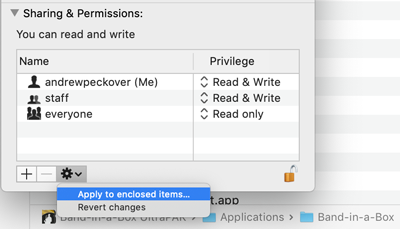 Example: Checking permissions of a folder
Example: Checking permissions of a folder Note: You can manage your user accounts by in System Preferences --> Users & Groups.
65. How do I install Band-in-a-Box on an external hard drive.
Band-in-a-Box is installed to the /Applications/Band-in-a-Box folder on the volume (disk) that you select in the installer. By default, Band-in-a-Box is installed on your Mac's internal hard drive. However, it can be installed on any disk that has sufficient space. You choose the disk on the Destination Select screen of the installer.
Note that usually the Installer application sometimes skips this screen (Installer.app is the application on your Mac that installs packages) and so you need to click the [Change Install Location] button.
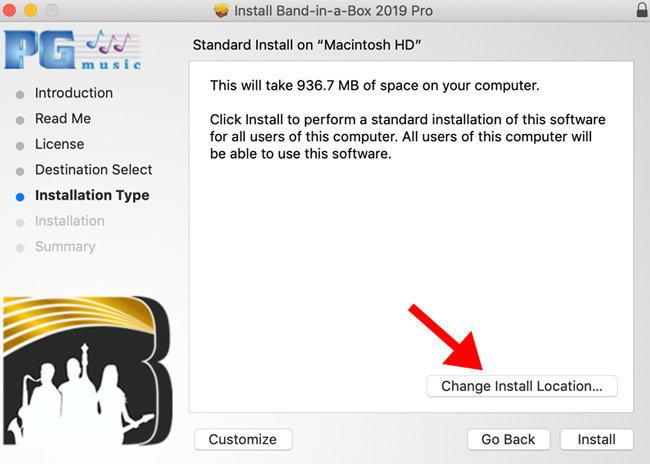 Installation Type screen
Installation Type screen 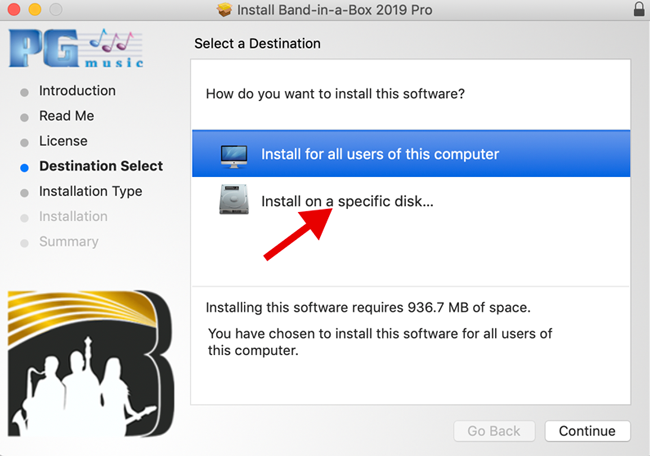 Destination Select screen 1 - Install on specific disk
Destination Select screen 1 - Install on specific disk 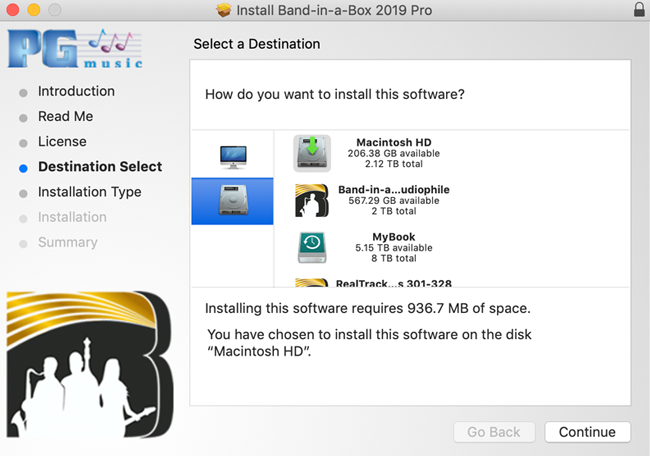 Destination Select screen 2 - Choose disk
Destination Select screen 2 - Choose disk 66. How do I install a Band-in-a-Box update or patch to an external hard drive?
You need to choose the Destination disk as explained in the previous topic.
67. How do I install RealTracks or "RealCombos" or other Band-in-a-Box content on an external hard drive?
RealTracks are installed the same way as Band-in-a-Box, and can be installed to any disk that has Band-in-a-Box installed in /Applications/Band-in-a-Box. You need to select the destination volume as explained in the previous topic.
If the installer doesn't let you select a particular volume, it is normally because there is not enough disk space, or Band-in-a-Box is not already installed. (i.e. "/Applications/Band-in-a-Box/Band-in-a-Box.app" does not exist). The installer will tell you what the reason is, as in the image below:
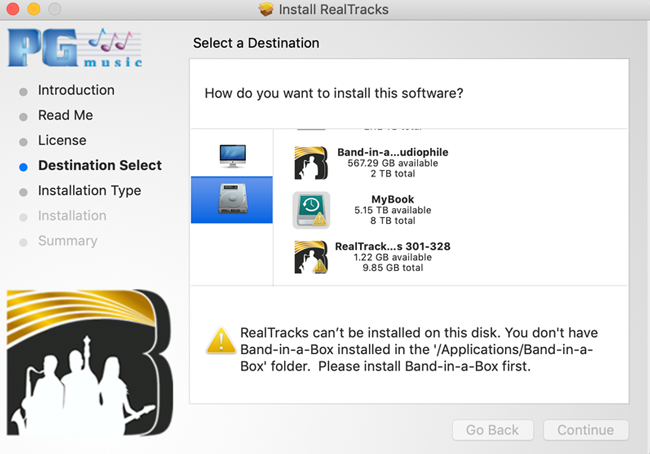 RealTracks cannot be installed; install Band-in-a-Box first
RealTracks cannot be installed; install Band-in-a-Box first The solution in this case is to install the Band-in-a-Box program first.
TIP: If you have a Band-in-a-Box folder already on your internal drive, and you want to move it to an external drive (maybe you are running low on disk space for example) before installing more RealTracks, one option you have is simply to copy your Band-in-a-Box folder from your Mac HD to the external drive (create the "Applications" folder on the external drive if you need to). Just make sure you have an /Applications/Band-in-a-Box folder on your target disk that contains Band-in-a-Box.app and the rest of the Band-in-a-Box subfolders like Data, Styles, Soloists, and so on.
68. I don't seem to be able to choose an external hard drive for installation!
First, look for the "Change Install Location" button or the Destination Select screen. If you've found that screen, but there is a "no can do" exclamation symbol on the drive you want to install to, take a look at what the reason is (there will be a short explanation given in the window below the list of volumes). If you are installing RealTracks and it says you need to install Band-in-a-Box first, then do that (i.e. run the main Band-in-a-Box program install).
Otherwise, note that there is a bug in Apple's Installer application that causes it to occasionally force installation to the internal hard drive. When this happens, the Select Destination screen might display a message "You must install to the disk containing OS X". This seems to be more common if you are running multiple installers at the same time. The solution is to restart the installation and/or wait until others are complete. If the issue persists, rebooting your Mac should fix it.
69. I am installing RealTracks. How do I choose a custom RealTracks (and Drums) folder location?
The short answer is that you can use the "Custom Install" screen; click the [Customize] button on the Installation Type screen.
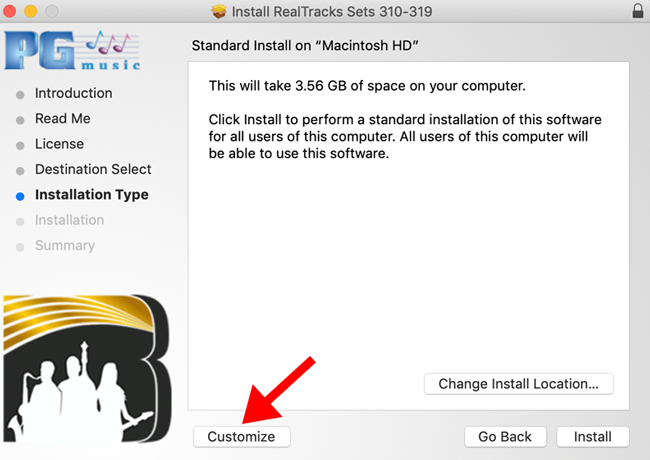 How to get to the Custom Install mode
How to get to the Custom Install mode Next, you can choose the location for your RealTracks folder (and Drums folder if applicable). Note that this is the folder that contains your custom RealTracks and Drums folders.
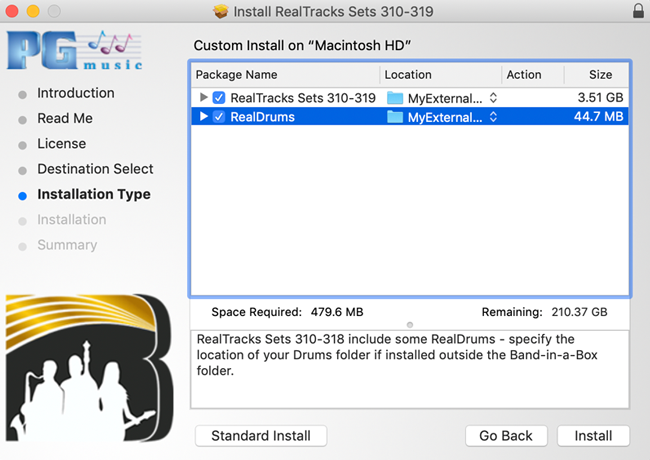 Custom Install - Choosing folder location.
Custom Install - Choosing folder location. Before you do this however, you should first understand that RealTracks content is made up of alot of different types of files - there are Styles (.STY files), Style Demos, Data files, Soloist databases, and Audio files (.m4a /.aiff / etc.). All of this content is by default installed to subfolders of the main Band-in-a-Box folder; "Styles", "Demos", and so on. The "RealTracks" folder, which contains the audio files, is the only folder that can be located outside of the main Band-in-a-Box folder - it is this location that you are choosing in the Custom Install screen.
We provide this option because the audio files are much larger in proportion to the rest of the files and some people wanted to store them on a different/external hard drive. Therefore we allow people to set custom Drums and RealTracks folder locations in the RealTracks and Drums preferences dialogs in Band-in-a-Box.
There are a few approaches for you to consider.
- Don't use a custom folder. Just install the whole program on the external hard drive if you don't have an internal hard drive with alot of space; this is far simpler and less error-prone, and Band-in-a-Box runs great from an external hard drive. Having the application on the internal drive and RealTracks folder on an external drive was more practical years ago. As we continue to add more content to Band-in-a-Box, the program as a whole is growing larger, not just the RealTracks folder. For example, in an UltraPAK the Soloists folder is around 30GB by itself.
Or... - Install the whole program to a hard drive without choosing a custom location. Once installed, move your RealTracks folder to wherever you want it. When copying your RealTracks folder, you can merge it to an existing RealTracks folder in another location by making sure to select the "Merge" option in Finder, and not "Replace".
- If you really want to, choose a custom folder location as described above (short answer), but then you need to remember to do that each time you install RealTracks content. Also, one caveat is that some of the larger RealTracks downloads have a RealTracks Packages folder, and with these you'll need to install the packages in that folder individually rather than running the simpler "Install all RealTracks" script.
70. I ordered an upgrade from a previous version - should I remove the previous version prior to installing the new version?
No, this is rarely beneficial. You should just install the new version right "over top" of your previous one. The new version is compatible with the existing content you have. If your new version is a Band-in-a-Box hard drive and you'll be running the program from the hard drive, then it already includes the previous content, with the exception of extra addons you may have purchased in the past, like Xtra Styles. For Xtra Styles, you should install them onto your new hard drive; they can be downloaded again if need be, from your PG Music account.
71. What is the best way to check if I am missing any content like Styles and RealTracks?
The best method is to check the StylePicker, RealDrums Picker, and RealTracks Picker windows. These windows use databases that know about all currently available content, whether or not you have it installed. (Note that there is a Help | What addons do I have dialog, however this is an older dialog that is not as useful, considering the vast amount of content now available for the program.)
StylePicker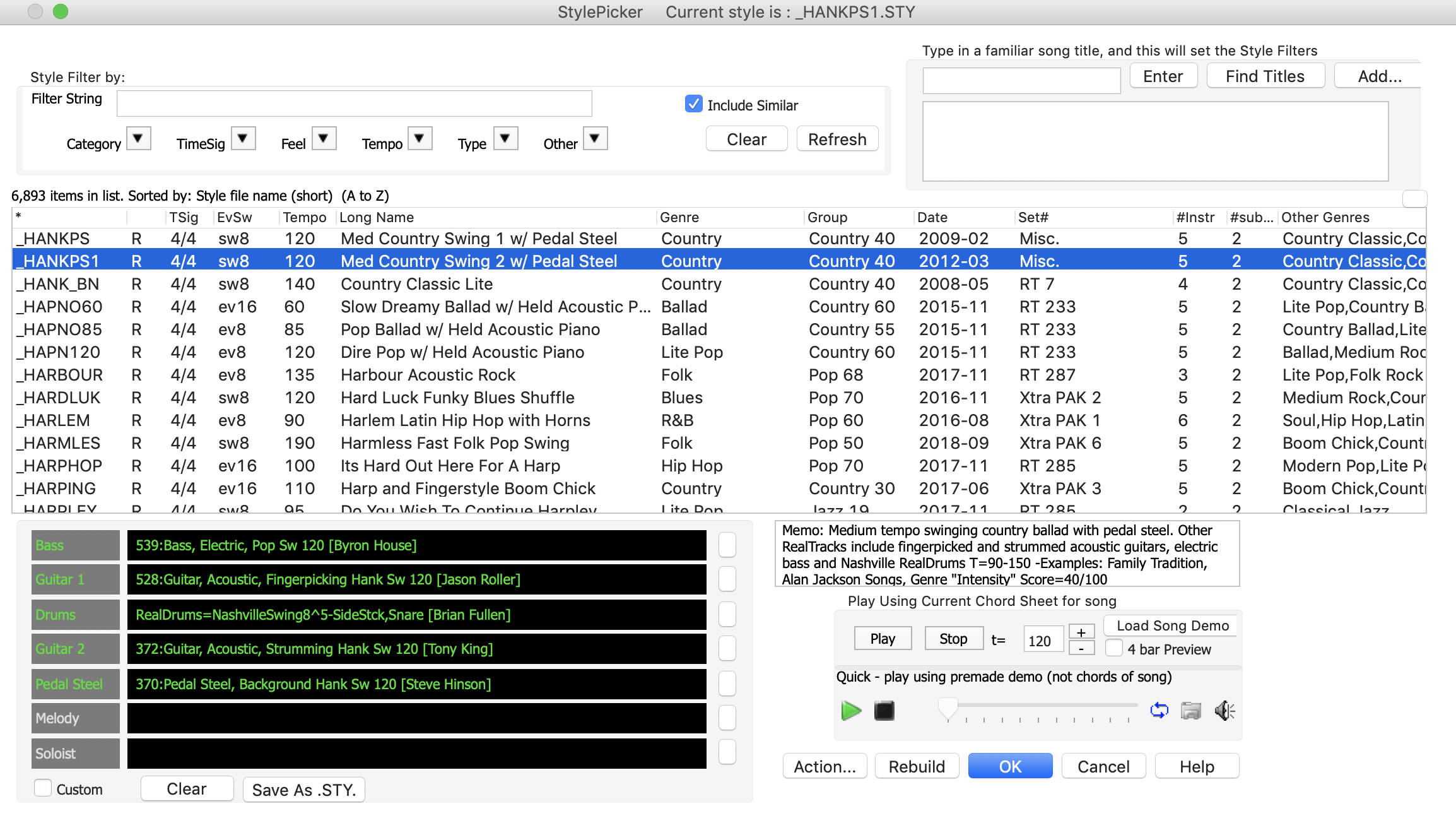 StylePicker window
StylePicker window Open the StylePicker and press the Rebuild (Fast) button if necessary. It isn't necessary to do a Slow rebuild - that just adds third party styles (i.e. ones that we didn't make) to the list.
The StylePicker can show you which styles you have and don't have. If you don't have them, they're listed as "N/A" (not available). A style (.STY file) can have one of more RealTracks and RealDrums instruments assigned to it. There are two types of "N/A" styles. The first type is when the styles are simply not present:
- Click the "Other" button > "Show Styles that are Found/Not Found [N/A]" > "Show ONLY N/A (not found) Styles" to display only styles you do not have.
- Click the "Other" button > "Show Styles that are Found/Not Found [N/A]" > "Show only Styles that are FOUND" to display only those styles that you have (this is the default setting).
It is normal to be missing some styles; one tip is to sort by the "SET #" column to get an idea of where these styles come from. Commonly, they will be from Xtra Styles sets, which aren't included in the base package.
The second type of N/A styles is when one or more RealTracks or RealDrums instruments needed in a style are missing ("RT N/A"). This MAY indicate an incomplete installation, but not necessarily. For example, if you don't have the latest UltraPAK version (current UltraPAK tpyically has all published RealTracks), but you install some Xtra Styles PAKs (styles that use existing RealTracks), then the Xtra styles may be calling for some RealTracks that you don't have. In this case, it doesn't mean there is a problem with your installation. You could choose to hide those styles or use them and substitute in RealTracks that you do have. The StylePicker also tells you which RealTracks # is missing, so you could cross reference that with the RealTracks Picker to find out more.
RealTracks PickerCheck the box at the bottom of the RealTracks Picker window "Show RealTracks that are N/A" (the default setting is unchecked). To see any missing RealTracks grouped together, you can sort by the "N/A" column and scroll to the top. It is also helpful sometimes to sort by "Set" since if you are missing a RealTracks instrument, you are more than likely missing the entire set or a group of adjacent sets. Note that unless you have an UltraPAK, it is normal to be missing alot of RealTracks. Even if you HAVE an UltraPAK you may be missing some Bonus RealTracks (these are often given a high set number like "800" to set them apart from the rest of the released RealTracks.)
There are two other types of N/A RealTracks, and these usually DO indicate an installation or settings problem. To be complete, RealTracks instruments need both a subfolder of audio files in the RealTracks folder, and also a database (*.ST2 file) in the Band-in-a-Box/Soloists folder. Here is an example of these two N/A types:
 RealTracks Picker - N/A types
RealTracks Picker - N/A types- The first ("N/A - RAcG.ST2 in BB") is telling you that Band-in-a-Box can find the RealTracks folder "Guitar, Acoustic, Strumming Ev 085" but it cannot find the RAcG.ST2 in the Band-in-a-Box/Soloists folder.
- The second ("N/A - RT Folder) is telling you that the .ST2 is found, but the RealTracks folder "Clarinet, Soloist DixielandFast Sw 165" is not found.
Typically the cause of #2 is using a custom RealTracks folder and not telling Band-in-a-Box where it is. This setting is in the RealTracks Preferences dialog. One tip is to use Finder search (Command+F) to locate the items in question.
RealDrums PickerCheck the box "Show RealDrums that are N/A", and you can then sort by the NA column to group them. Since all of the RealDrums files are in the Drums folder, Drums are either N/A or not. One cause of Drums being N/A is if you have located the Drums folder in a custom location, but have not set this location in the RealDrums Preferences.
If you don't have the UltraPAK then you will have quite a few N/A drums. In addition, there are some "Multi-drums" made specifically for, and included with, certain Xtra Styles.
72. I upgraded and don't seem to have some Band-in-a-Box add-ons like Xtra styles that I have purchased in the past?
This could be the case if you installed your upgrade into a different folder than previous version, or if you have a new Band-in-a-Box hard drive. If you have a new UltraPAK hard drive, you should install your previously purchased Xtra Styles onto it - if you need to you can always sign into your account and re-download them.
73. I ordered an UltraPAK or PlusPAK upgrade as a download product... how do I download and install the RealTracks?
With an UltraPAK upgrade, you typically don't need to download all the RealTracks files available if you have a previous version UltraPAK. Check the README item on your download page to see what you need; the rest of the files are there for your convenience.
Download and install the Band-in-a-Box program first. This will typically be the file at the top of the download list. You can still use Band-in-a-Box while you're waiting for all the rest of the larger files to download.
The RealTracks downloads are typically combined into large disk images. After downloading, you can mount the disk images (note that mounting doesn't take up any extra disk space). You can launch the package "Install All RealTracks" to install all the RealTracks included on the disk image. It might take several minutes to complete. Once you're finished installing you can unmount the disk image by "ejecting" it (select it and press Command+E).
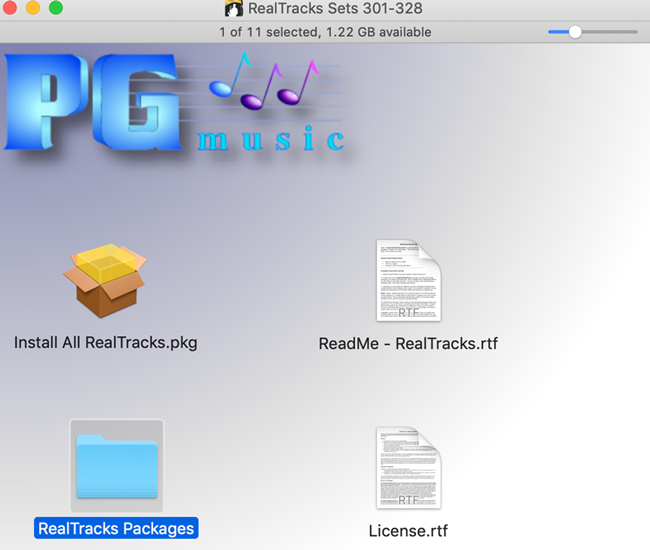 RealTracks download - disk image
RealTracks download - disk image 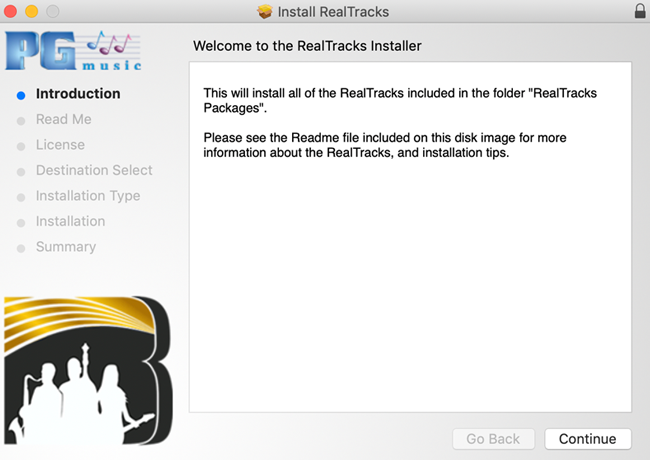 RealTracks install - welcome
RealTracks install - welcome 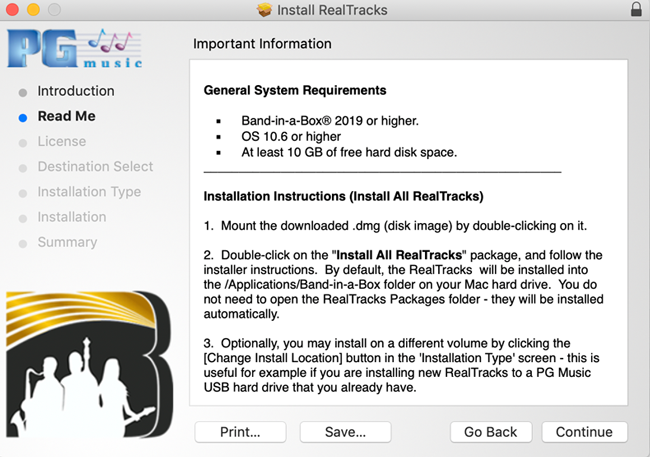 RealTracks install - readme
RealTracks install - readme 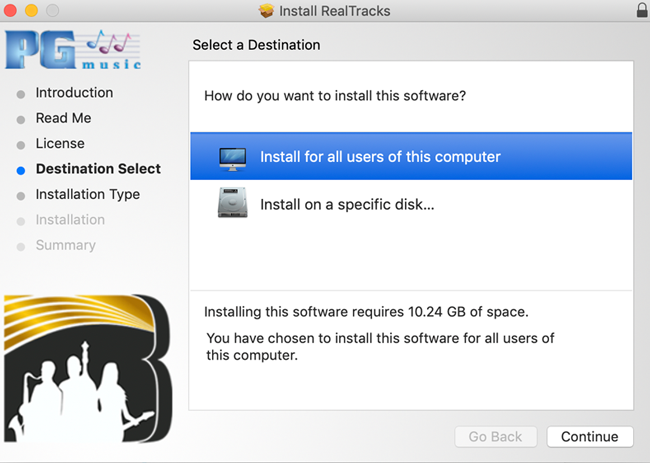 RealTracks install - choose the destination disk
RealTracks install - choose the destination disk 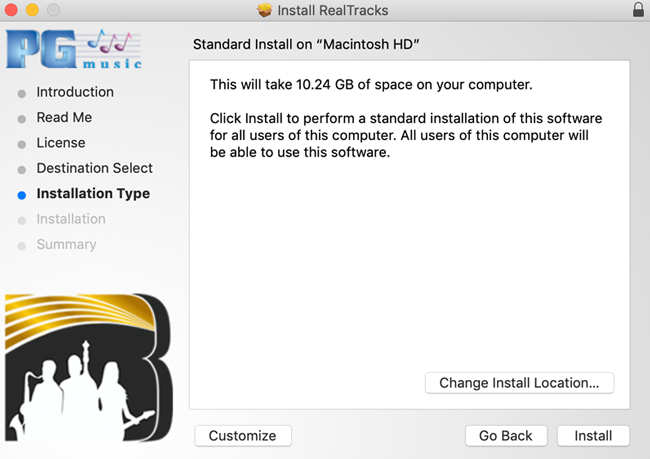 RealTracks install - installation type
RealTracks install - installation type Note that you if you want to choose a custom folder for the RealTracks (see this topic for an explanation) you'll need to open the RealTracks Packages folder and install each package individually.
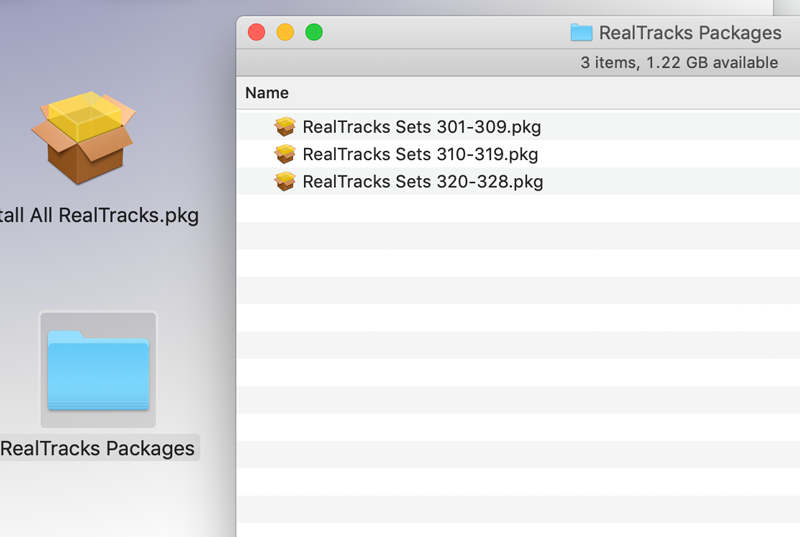 RealTracks Packages folder - for custom installs
RealTracks Packages folder - for custom installs 74. When I try to run a downloaded installer, I get a message that it can't be run because it is not from an identified developer, not from the app store, or it cannot be checked for malicious software.
To resolve this problem simply right-click on the file (or control-click), and select Open. The same message will be displayed, but you'll have the option to run the installer anyways.
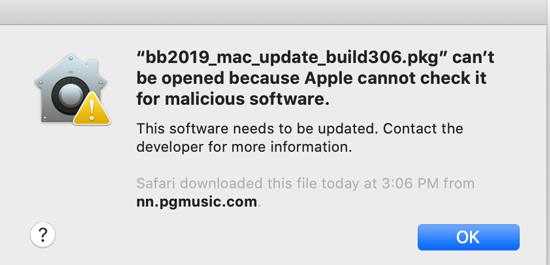 Example - Installer blocked from opening (can't be checked for malicious software)
Example - Installer blocked from opening (can't be checked for malicious software) 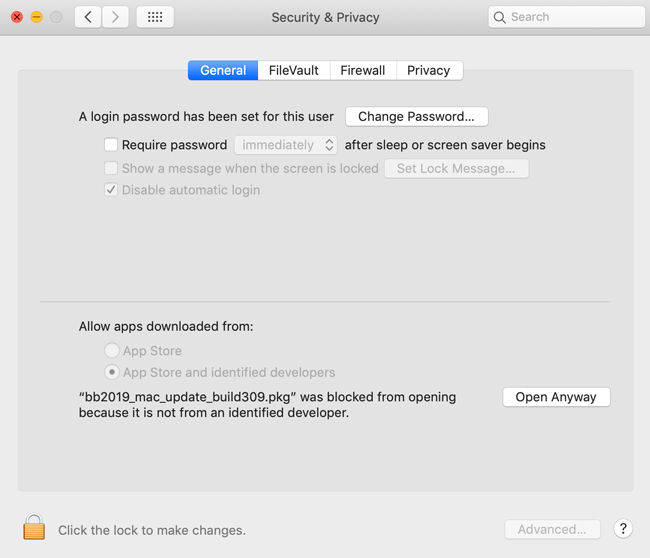 System Prefs - Security Settings - General (Gatekeeper settings)
System Prefs - Security Settings - General (Gatekeeper settings) Explanation:
There are a few different messages you can get, which are associated with Apple's "Gatekeeper" feature which tries to protect the user from unintentionally downloading and installing harmful software. With each new OS, the requirements tend to become more strict and new security features are added. There are security settings in System Preferences --> Security & Privacy. If you've recently been blocked from installing a product you might see it listed in this dialog, as in the screenshot below.
 System Prefs - Security Settings - General (Gatekeeper settings)
System Prefs - Security Settings - General (Gatekeeper settings) Note that the "Allow applications downloaded from anywhere" option used to be present but is hidden by default in Sierra onward.
- "... was blocked from opening because it is not from an identified developer", or "...is not from the app store". This usually means that the installer does not have a valid digital signature. This would typically only affect older installers, since we digitally sign all of our current installers. With strict settings, Gatekeeper will also complain if the download is not from the app store. This will affect all of our software since it isn't distributed through the app store. You might consider allowing identified developers in the security settings.
- "... can't be opened because Apple can't check it for malicious software. This is caused by a security feature introduced in OS 10.15, which expects the downloaded software to have gone through notarization by Apple. Most of our current software should be notarized, however security requirements may have changed since the app or installer was last compiled, or it might be an older installer.
75. I am getting various security warnings while installing and running Band-in-a-Box, asking if it's ok to allow Installer to control Finder or do specific tasks.
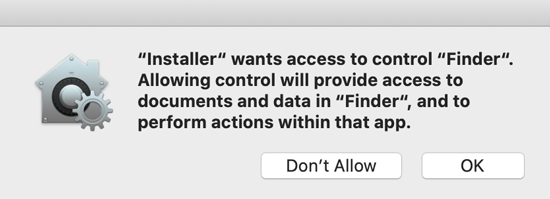 Example - Allow Installer to control Finder.
Example - Allow Installer to control Finder. 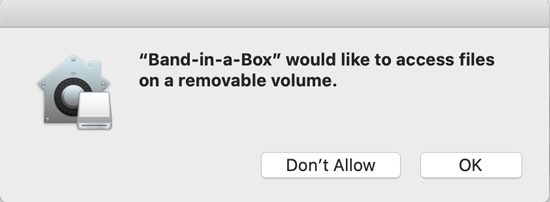 Example - Allow Installer to access files on removable volume.
Example - Allow Installer to access files on removable volume. 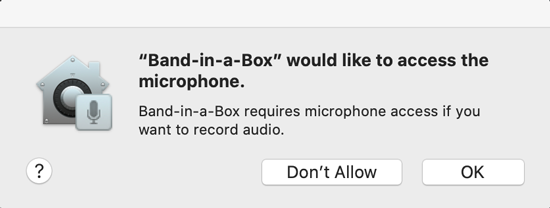 Example - Allow Band-in-a-Box to access mic.
Example - Allow Band-in-a-Box to access mic. With newer Mac OS's (Catalina and higher in particular), apps need to ask permission to do alot of different things, such as accessing personal files, running scripts, using the microphone, and so on. Our programs aren't trying to do anything malicious, just normal tasks for an installation script and music software program, so you'll need to allow access for the programs to function properly.
You can give apps permission and view your current settings in System Preferences --> Security & Privacy --> Privacy.
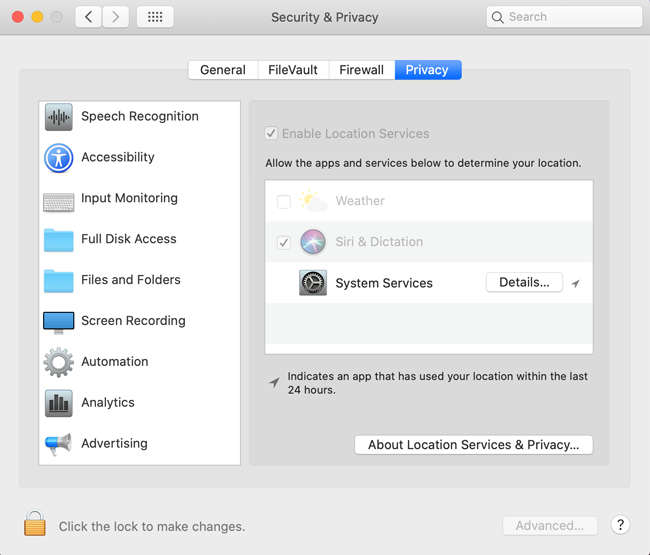 System Prefs - Security Settings - Privacy
System Prefs - Security Settings - Privacy 76. How do I set Band-in-a-Box as the default app to open all Band-in-a-Box song files.
Right-click on one of the song files and select Get Info. In the "Open With" section, choose Band-in-a-Box.app, then click the [Change All..] button.
77. When I try to run the program, I get "Error - Cannot read/write files". The error message typically mentions a problem with Data and Preferences, and points to a long folder path under the /private/var/folders directory.
This is probably caused by Apple's "App Translocation" security feature that is part of newer Mac operating systems. You might see an error message that looks something like this:
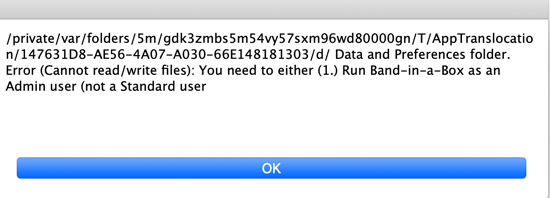 Example - App Translocation problem.
Example - App Translocation problem. This can be caused by trying to run an app that was downloaded in a zip file. App Translocation prevents apps that are downloaded like this from being run normally - instead they are copied to a temporary unwritable location and run from there. Band-in-a-Box cannot run properly like this. You are not likely to encounter this error under normal circumstances, since Band-n-a-Box is normally distributed in a digitally signed and notarized installer package.
78. Can I install and run Band-in-a-Box from a network drive?
Yes, you can run Band-in-a-Box from a network drive in most cases. Note that Band-in-a-Box must be installed and activated on your local Mac, so this is not a multi-user solution. Note that the Installer program will not allow you to select a network drive as your target, so you will need to install the program on a locally-attached drive first. Once you have installed Band-in-a-Box, you could copy the entire Band-in-a-Box folder to your network drive and run it from there. You don't need to keep all of the RealTracks files etc. on your local drive. As long as you keep the core Band-in-a-Box files (/Applications/Band-in-a-Box/Band-in-a-Box.app in particular), you should be able to install additional content or patches, and copy/merge the new content to your other location.
Note that you're accessing the network volume via file sharing. If you select the volume on your desktop and open the Get Info panel, you will see that the volume format is either "AFP" or "SMB". If you are having trouble running Band-in-a-Box and you're using the AFP protocol, try switching to SMB. You should be able to change this via Go menu | Connect to Server.
79. Can I copy the entire Band-in-a-Box folder to another hard drive?
Yes, and there are a few reasons why might want to do this - e.g. for backup purposes, if you would like to run Band-in-a-Box from an external drive, if your internal Mac hard drive is running out of space, or if you are reinstalling your OS. Note - if you are reinstalling your OS or using a new Mac, you will need to run the main program installer (just the one single Band-in-a-Box package, not all of the content/RealTracks packages), so that the fonts, plugins, etc. are installed properly. Aside from those files, Band-in-a-Box is largely self-contained in it's own folder. You will also need to re-activate the program again with your serial number. If you are moving to a new Mac, you should De-activate on your old Mac so that you have an activation available for the new one.
80. Error message when opening Band-in-a-Box: Unable to open file ... RealTracksSubs.txt
This error might occur if launching Band-in-a-Box from an external hard drive, and Band-in-a-Box does not have permission to access removable volumes. (This is a security feature in Mac OS Catalina and higher).
To fix this, go to the Apple system Preferences | Security & Privacy. Band-in-a-Box needs to be listed (and selected) in the Full Disk Access section, AND/OR listed in the Files and Folders section with 'removable volumes' selected. Normally this isn't an issue, unless when you first used Band-in-a-Box and were asked, you denied it access. You can click on Full Disk Access section, click the + button, and select the Band-in-a-Box.app from the /Applications/Band-in-a-Box folder.
81. Error message when opening Band-in-a-Box: Unable to create file ... stylz_kategoriesERRORS.txt
This error may occur if Band-in-a-Box does not have read/write access to some parts of the Band-in-a-Box folder.
To solve this problem, you can download and install the latest update patch for your version.
You can alternatively fix this manually:
- Click on the /Applications/Band-in-a-Box® folder, and go to File | Get Info, or press Command-I.
- Press the UNLOCK button at the bottom right of the dialog.
- In the Sharing and Permissions tab, set Privliges for all the groups to "Read and Write"
- Press the WheelGear button at the bottom (beside the + - buttons), and choose "Apply to Enclosed Items".
Unconditional 30-Day Money Back Guarantee on all PG Music products purchased from PG Music Inc.
PG Music Inc.
29 Cadillac Ave Victoria BC Canada V8Z 1T3
Sales: 800-268-6272, 250-475-2874,+ 800-4746-8742*
* Outside USA & Canada where International Freephone service is available.
Access Codes
Tech Support: Live Chat, support@pgmusic.com
 Online now
Online now
Need Help?
Customer Sales & Support
|
Phones (Pacific Time) 1-800-268-6272 1-250-475-2874 |
||
| Live Chat | ||
| OPEN | Online Ordering 24/7 |
|
| OPEN | Forums, email, web support |
